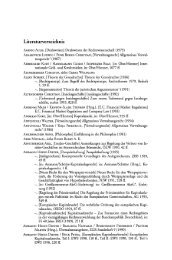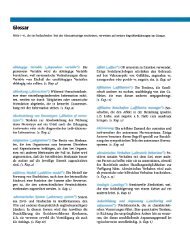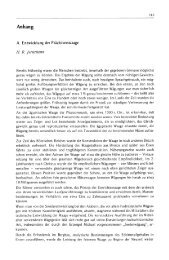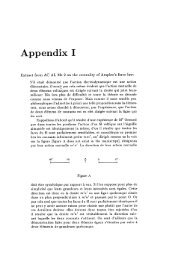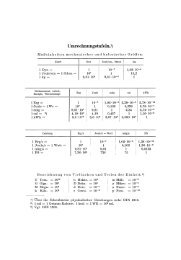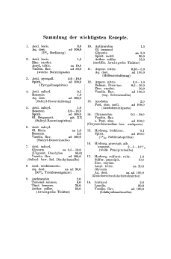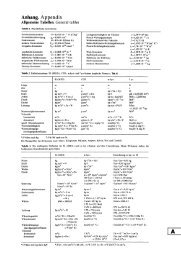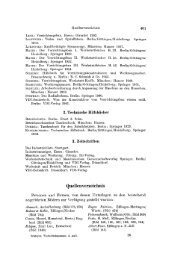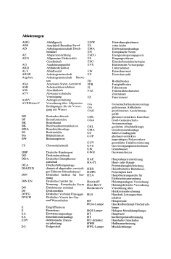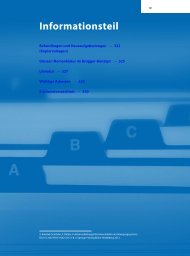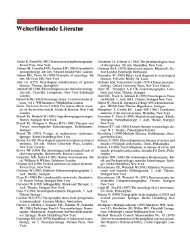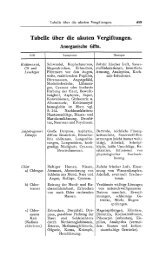Download PDF - Springer
Download PDF - Springer
Download PDF - Springer
- No tags were found...
You also want an ePaper? Increase the reach of your titles
YUMPU automatically turns print PDFs into web optimized ePapers that Google loves.
247ServiceteilGlossar – 248Kontaktadressen, Bezugsquellen und Internet-Links – 250Literatur – 255Stichwortverzeichnis – 265M. Prosiegel, S. Weber, Dysphagie: Diagnostik und Therapie,DOI 10.1007/978-3-642-35104-4, © <strong>Springer</strong>-Verlag Berlin Heidelberg 2013
248 ServiceteilGlossarAditus laryngis Kehlkopfeingang; begrenzt vom Epiglottisrand(vorn), den aryepiglottischen Falten (seitlich) und derhinteren Kommissur (hinten)Aspiration Eindringen von Material (Nahrung, Flüssigkeit,Speichel etc.) in die Luftwege, unterhalb der GlottisebeneAspiration, stille Eindringen von Speichel, Sekret oderanderem Material in die Luftröhre ohne HustenAspirationspneumonie Lungenentzündung infolge einerAspiration: bakteriell verunreinigtes Material gerät imRahmen einer Aspiration über die Luftröhre und die Bronchienin die LungeBolus schluckfertiger BissenBotulinum-Neurotoxin Lebensmittelgift, das bei geringstenDosen zum Krankheitsbild des Botulismus führenkann; seit mehreren Jahren auch als Medikament eingesetzt,das bei intramuskulärer Injektion zur (mehrmonatigen)Muskelerschlaffung bzw. bei Injektion in die Ohr- bzw. Unterkieferspeicheldrüsenzu einer Verminderung des SpeichelflussesführtDivertikel sackförmige Ausstülpung der Wände von Hohlorganen,z.B. des Rachens (z.B. Zenker-Divertikel) oder derSpeiseröhre (z.B. Traktionsdivertikel); beim echten Divertikel(z.B. Traktionsdivertikel) sind alle Wandbestand teile betroffen,beim falschen Divertikel (z.B. Zenker- Divertikel) stülptsich nur die Schleimhaut ausDysphagie SchluckstörungErnährung, enterale (griechisch enteron = Darm) Ernährungüber in den Magen-Darm-Trakt eingebrachte SondenErnährung, parenterale intravenöse Verabreichung derNährstoffe unter Umgehung des VerdauungstraktesFasern, kortikobulbäre Fasern, die von kortikalen Motoneuronenzu motorischen Hirnstammkernen verlaufenFazialisparese, periphere Lähmung einer Gesichtshälfteinfolge einer Schädigung des Nervus facialis (VII. Hirnnerv)Fazialisparese, zentrale Lähmung einer Gesichtshälfte (mitAusnahme der Stirnmuskulatur) infolge einer Schädigungdes Gesichtsareals der Großhirnrinde oder der von dort zumHirnstamm (Fazialiskern) verlaufenden kortikobulbärenFasernFEES Flexible endoskopische Evaluation des Schluckensnach transnasaler Einführung eines Nasopharyngolaryngoskops(NPL)Gastrostomie, perkutan endoskopische (PEG) Verfahren,bei dem eine Sonde zur enteralen Ernährung unter endoskopischerKontrolle aus dem Magen direkt über die Bauchwandnach außen vorgeschoben wird (bei der meistverwendetenFadendurchzugsmethode)Hustenreflex Schutzreflex, zur Beseitigung von Fremdkörpernund Sekretansammlungen aus den AtemwegenHyoid ZungenbeinHyolaryngeale Exkursion Bewegung von Zungenbeinund Kehlkopf nach vorn und obenHypersalivation vermehrte Speichelproduktion (fastimmer medikamentös bedingt; insbesondere durch atypischeNeuroleptika bzw. Cholinergika)Insel, vordere Hirnabschnitt, der sich unter dem (frontoparietalenund temporalen) Operkulum befindet; wichtigerTeil des SchluckkortexLarynx KehlkopfLeaking (engl. Leck/leckschlagen) unkontrolliertesEnt gleiten oraler Bolusanteile vor der SchluckreflexauslösungLeaking, anteriores Leaking nach vorn aus dem MundLeaking, posteriores Leaking nach hinten in den Rachenraum= Pooling (engl. Ansammlung/sich ansammeln)Manometrie, pharyngeale bzw. ösophageale Druckmessungim Rachen- bzw. ÖsophagusbereichMyotomie, cricopharyngeale Muskeldurchtrennung desoberen Ösophagussphinkters, bestehend aus M. cricopharyngeus,dem unteren Teil des M. constrictor pharyngisinferior und dem oberen quergestreiften Ösophagus;indiziert bei primärer Öffnungsstörung des oberen ÖsophagussphinktersNahrungskarenz, orale vollständiger Verzicht auf Nahrungs-und Flüssigkeitsaufnahme über den MundNasogastrale Sonde (NGS) Sonde zur enteralen Ernährung,die über die Nase in den Magen vorgeschoben wirdM. Prosiegel, S. Weber, Dysphagie: Diagnostik und Therapie,DOI 10.1007/978-3-642-35104-4, © <strong>Springer</strong>-Verlag Berlin Heidelberg 2013
Glossar249Operkulum, frontoparietales wichtiger Abschnitt desSchluckkortex: unterer Abschnitt der primären sensomotorischenRinde sowie des angrenzenden prämotorischenKortexÖsophagus Speiseröhre; etwa 18 bis 25 cm lang; beginntunter dem oberen Ösophagussphinkter und verläuft alssog. tubuläre Speiseröhre bis zu ihrem untersten Teil, demunteren Ösophagussphinkter, der am Mageneingangendet; die (innere zirkuläre und äußere längsverlaufende)Muskelschicht besteht oben aus quergestreiften, unten ausglatten Muskelfasern, im mittleren Drittel aus einer Kombinationbeider FasertypenÖsophagussphinkter, oberer (oÖS) oberer Schließmuskelder Speiseröhre (zwischen Rachen und Speiseröhre); gehörtzur quergestreiften RachenmuskulaturÖsophagussphinkter, unterer (uÖS) unterer Schließmuskelder Speiseröhre am Übergang zum Magen; besteht ausglatten MuskelfasernPEG vgl. Gastrostomie, perkutane endoskopischePenetration, laryngeale Eindringen von Speichel, Sekretoder anderem Material in den Aditus laryngis, oberhalb derGlottisebenePenetration, nasale Eindringen von Speichel, Sekret oderanderem Material in die NasePeristaltik einschnürende Kontraktionen der Muskulaturvon Hohlorganen (z.B. des Pharynx, der Speiseröhre);dient physiologischerweise dem Bolustransport bzw. derEntfernung von BolusrestenSchluckkortex der Teil der Großhirnrinde, der für (will kürliches)Schlucken verantwortlich ist, insbesondere frontoparietalesOperkulum und vordere InselSchluckreflex willkürlich nicht zu beeinflussende Kontraktionzahlreicher Muskeln am Beginn der pharyngealenPhase; Anfang wird meist definiert als Beginn der Hyoidbewegungoder des »White-out-Phänomens«Sialorrhoe vermehrter Speichelfluss, der bei Menschen mitDysphagie fast immer auf einem verminderten Abschluckenvon Speichel beruhtSinus piriformis seitliche Ausbuchtungen im unterenHypopharynxValleculae epiglotticae paarige Vertiefungen zwischenZungengrund und EpiglottisVideoendoskopie des Schluckens Videogestützte transnasaleUntersuchung mit einem flexiblen Endoskop zurBeurteilung von Struktur und Funktion des Pharynx und desLarynx; siehe FEESVideofluoroskopie des Schluckens (VFSS) röntgenologischeUntersuchung des Schluckens mit einer Bildfrequenzvon etwa 25 bis 30 Bildern/sWhite-out-Phänomen Phase während des Schluckens(intradeglutitiv), bei der in der FEES die Sicht versperrt ist(stattdessen wird nur reflektiertes Licht wahrgenommen)Xerostomie Mundtrockenheit; Ursachen: Medikamente(z.B. Anticholinergika), Bestrahlungen von HNO-Tumoren,Krankheiten wie z.B. das Sjögren-SyndromPooling (engl. Ansammlung/sich ansammeln) = posterioresLeaking Leaking nach hinten in den RachenraumReflux, gastroösophagealer Zurückfließen von Mageninhaltin die SpeiseröhreRegurgitation Wiederhochkommen von Nahrung etc. ausder Speiseröhre in den Rachen-, Kehlkopf- oder Mundraumaufgrund retrograder Bewegungen der ösophagealenMuskulaturRegurgitation, nasale vgl. Penetration, nasaleResiduen Verbleiben von Speichel, Nahrung oder Flüssigkeitim Rachen oder im Mund nach dem SchluckenRetention Vorgang, der zu Residuen führtSchluckapraxie umstrittene Apraxieform, bei derapraktische Symptome insbesondere die orale Phasebzw. die Zunge betreffen
250 ServiceteilKontaktadressen, Bezugsquellen und Internet-LinksKontaktadressen(7 auch http://extras.springer.com, 34_Kontaktadressen.pdf)BKL – Bundesverband Klinische LinguistikMedau-SchuleSchloß Hohenfels96450 CoburgTel.: 09561/23510, Fax: 09561/235134E-Mail: mail@bkl-ev.dewww.bkl-ev.deZentrum für Schluckstörungender Fachklinik Bad HeilbrunnWörnerweg 3083670 Bad HeilbrunnTel.: 08046/183333, Fax: 08046/184083E-Mail: dysphagie@fachklinik-bad-heilbrunn.dewww.fachklinik-bad-heilbrunn.dedbl – Deutscher Bundesverbandfür Logopädie e.V.Augustinusstr. 11a50226 FrechenTel.: 02234/37953-0, Fax: 02234/37953-13E-Mail: info@dbl-ev.dewww.dbl-ev.dedbS – Deutscher Bundesverbandder akademischen SprachtherapeutenGoethestraße 1647441 MoersTel.: 02841/988919, Fax: 02841/988914E-Mail: info@dbs-ev.dewww.dbs-ev.deKölner Dysphagiezentrum: Fachinstitutfür Menschen mit Schluckstörungenund ihre AngehörigenMotzko/Weinert GbRHelios-HausVenloer Str. 38950825 KölnTel.: 0221/9123702, Fax: 0221/9123701E-Mail: info@dysphagiezentrum.dewww.dysphagiezentrum.deM. Prosiegel, S. Weber, Dysphagie: Diagnostik und Therapie,DOI 10.1007/978-3-642-35104-4, © <strong>Springer</strong>-Verlag Berlin Heidelberg 2013
Kontaktadressen, Bezugsquellen und Internet-Links251Bezugsquellen(7 auch http://extras.springer.com, 35_Bezugsquellen.pdf)Andickungsmittel4 Reformhäuser4 Apotheken4 Fresenius Kabi AGCorporate CommunicationsD-61346 Bad Homburg v.d.H.Tel.: 06172/6860www.fresenius-kabi.com4 Nestlé HealthCare Nutrition GmbHLyoner Str. 23D-60523 Frankfurt/Mainhttp://nutrinews.nestle.deVertrieb:Nestlé HealthCare Nutrition GmbH81379 MünchenBiofeedbackgerät (z. B. Loguva)Haynl-Elektronik GmbHMagdeburger Str. 117aD-39218 SchönebeckTel.: 03928/69414www.haynl.comBogenhausener Dysphagiescore (BODS)http://www.egms.de/static/en/meetings/dgpp2006/06dgpp37.shtmlDysphagie-PassKlinik für Altersmedizin und GeriatrieChefarzt Dr. Martin Jäger (Sekretariat)Otto-Seibel-Str. 31-3346535 Dinslakenandrea.brinker@st-vinzenz-hospital.deErnährungsdokumentationNestlé HealthCare Nutrition GmbH (s.o.)http://nutrinews.nestle.deEss- und Trinkhilfen4 Andreas Fahl Medizintechnik – Vertrieb GmbHAugust-Horch-Str. 4aD-51149 KölnTel.: 02203/2980-0www.fahl-medizintechnik.de4 UBM Beratungs- u. HandelsunternehmungUwe MausHauptstr. 15aD-55595 BurgsponheimTel.: 06758/803291www.einkauf-pflege.de4 SANIMEDThannstr. 6A-5322 Hof bei SalzburgTel.: +43(0)650/6668881www.sanimed.de4 Thomashilfen für Behinderte GmbH & Co.Medico KGWalkmühlenstr. 1D-27432 BremervördeTel.: 04761/8860www.thomashilfen.deFEES-Einverständnis erklärungwww.diomed.de/produkte/aufklaerungsboegen/hno/halsrachenmund/hier »Pharyngo-Larnygoskopie« aufsuchenGUSShttp://www.orl.usz.ch/SiteCollectionDocuments/GUSS%20%20Deutsch%20Version%201_09%201.pdfSchiebelöffel (glossectomy spoon)4 AliMed, Inc.Medical and Ergonomic Products for Healthcare,Business, and Home297 High StreetDedham, MA 02026, USATel.: 001-800-225-2610www.alimed.com4 RehabMart, LLC150 Sagewood DriveWinterville, GA 30683-1563, USAToll Free: 001-800-827-8283Direct: 001-706-213-1144www.rehabmart.com
252 ServiceteilKieferöffnungshilfe TheraBite 4 Atos Medical GmbHCarl-Schuricht-Str. 3D-65187 WiesbadenTel.: 0611/4457000www.atosmedical.com4 Andreas Fahl Medizintechnik –Vertrieb GmbH (s.o.)www.fahl-medizintechnik.dePatientenaufklärungsbogenKölner DysphagiezentrumMotzko/Weinert GbRHelios-HausVenloer Str. 38950825 KölnTel.: +49(0)221-9123702info@dysphagiezentrum.dePharyngo-Laryngoskopiewww.diomed.de/produkte/aufklaerungsboegen/hno/halsrachenmund/hier »Pharyngo-Laryngoskopie« aufsuchenThermosondeLarynxspiegel/Zahnspiegel Größe 004 Sanitätshäuser4 Fachhandel für HNO-ärztlichenoder zahnmedizinischen Bedarf4 Fresenius Kabi AG (s.o.)www.fresenius-kabi.com4 Nestlé HealthCare Nutrition GmbH (s.o)http://nutrinews.nestle.de4 Pfrimmer Nutricia GmbHAm Weichselgarten 23D-91058 ErlangenTel.: 09131/7782-0www.pfrimmer-nutricia.de4 HiPP GmbH & Co. Vertrieb KGGeorg-Hipp-Str. 7D-85276 Pfaffenhofen (Ilm)Tel.: 08441/757-0www.hipp.de
Wichtige Internet-Links: Von A bis Z253Wichtige Internet-Links: Von A bis Z(7 auch http://extras.springer.com, 01_Internet-Links.pdf)Aktuelle Ratschläge des Institutes für RehabilitationLaryngektomierter (I.R.L.)Vorbeugung und Behandlung von Schleimhauthautschädenund Mundtrockenheit nach Bestrahlungund/oder Chemotherapie im Kopf-/Hals-Bereichwww.irl-institut.de/docs/literatur/Schleimhautschaeden.pdfÄZQ – Ärztliches Zentrum für Qualität in derMedizinwww.aezq.de/Barthel-Index (einschl. Hamburger Einstufungsmanual)www.dimdi.de/static/de/klassi/diagnosen/icd10/hamburger_manual.pdfBODS – Bogenhausener Dysphagiescorehttp://www.egms.de/static/en/meetings/dgpp2006/06dgpp37.shtmlDeutscher Bundesverband der akademischenSprachtherapeutenwww.dbs-ev.deDeutscher Bundesverband für Logopädie e. V.www.dbl-ev.deDeutsche interdisziplinäre Gesellschaftfür Dysphagie (DGD)www.dg-dysphagie.deDGN-Leitlinie »Neurogene Dysphagien«(Deutsche Gesellschaft für Neurologie)www.dgn.org oder als App »Neurogene Dyspha gien«für 1,79 € herunterzuladenESPEN-Guidelines: Geriatricswww.espen.org/documents/ENGeriatrics.pdfGUSS - Gugging Swallowing Screenwww.orl.usz.ch/SiteCollectionDocuments/GUSS%20-%20Deutsch%20Version%201_09%201.pdfhttp://stroke.ahajournals.org/content/38/11/2948.fullICD-10-GM, ICF und andere Klassifikationen –Deutsches Institut für MedizinischeDokumentation und Information (DIMDI)4 Deutsches Institut für Medizinische Dokumentationund Information (DIMDI)www.dimdi.de4 ICD-10-GM Version 2013www.dimdi.de/static/de/klassi/diagnosen/icd10/htmlgm2013/index.htm4 ICF (Endfassung Stand Oktober 2005)www.dimdi.de/dynamic/de/klassi/downloadcenter/icf/endfassung/ICFwww.dimdi.de/dynamic/de/klassi/downloadcenter/icf/endfassung/icf_endfassung-2005-10-01.pdfKDZ – Kölner Dysphagiezentrum: Fachinstitutfür Menschen mit Schluckstörungen und ihreAngehörigenwww.dysphagiezentrum.deE-Mail: info@dysphagiezentrum.deKreatinin-Clearancewww.tellmed.ch/tellmed/Tools/Diagnostische_Scores_Berechnungen/Kreatininclearance_nach_Cockcroft.phpLSVT (Lee Silverman Voice Treatment) –OFFICIAL LSVT FOUNDATION WEBSITEwww.lsvt.orgMedikamentengabe über Sondewww.enterale-ernaehrung.de/internet/kabi/enteral/entern.nsf/AttachmentsByTitle/Medikamen tengabeSonde/$FILE/MedikamentengabeueberSonde20080630.pdfMNA TM – Mini Nutrional AssessmentAnamnesebogen zur Bestimmung des Ernährungszustandesälterer Menschenwww.mna-elderly.com/forms/MNA_german.pdfNOD-Stufenkonzeptwww.uniklinik-ulm.de/uploads/media/NOD_Stufenkonzept_05.pdf
254 ServiceteilPEGwww.espen.org/documents/PEG.pdfReanimationwww.kinderreanimation.atSchluckender FetusDas Video (Ultraschalluntersuchung) zeigt einenschluckenden Fetus (13 Wochen und 4 Tage alt).www.youtube.com/watch?v=2dwTYW3u4N4Statistisches Bundesamtwww.destatis.deWebsite der Fachklinik Bad Heilbrunnwww.fachklinik-bad-heilbrunn.deE-Mail: dysphagie@fachklinik-bad-heilbrunn.de
255LiteraturAbele M, Bürk K, Schöls L, Schwartz S, Besenthal I, Dichgans J,Zühlke C, Riess O, Klockgether T (2002) The aetiology ofsporadic adult-onset ataxia. Brain 125: 961–968AbuRahma AF, Lim RY (1996) Management of vagus nerveinjury afer carotid endarterectomy. Surgery 119: 245–247Adnerhill I, Ekberg O, Groher ME (1989) Determining normalbolus size for thin liquids. Dysphagia 1989;4: 1–3Ajemian MS, Nirmul GB, Anderson MT, Zirlen DM, Kwasnik EM(2001) Routine fiberoptic endoscopic evaluation of swallowingfollowing prolonged intubation: implications formanagement. Arch Surg 136: 434–437Alfonsi E, Merlo IM, Ponzio M, Montomoli C, Tassorelli C, BiancardiC, Lozza A, Martignoni E (2010) An electrophysiologicalapproach to the diagnosis of neurogenic dysphagia:implications for botulinum toxin treatment. J Neurol NeurosurgPsychiatry 81: 54–60Albeldawi M, Makkar R (2012) Barium aspiration. N Engl J Med366:11Ali GN, Laundl TM, Wallace KL, Shaw DW, Decarle DJ, Cook IJ(1994) Influence of mucosal receptors on deglutitive regulationof pharyngeal and upper esophageal sphincterfunction. Am J Physiol 267: G644–649Ali GN, Wallace KL, Laundl TM, Hunt DR, deCarle DJ, CookIJ (1997) Predictors of outcome following cricopharyngealdisruption for pharyngeal dysphagia. Dysphagia 12:133–139Armstrong RW, Fung PC (1993) Brainstem encephalitis (rhombencephalitis)due to Listeria monocytogenes: case reportand review. Clin Infect Dis 16: 689–702Avery-Smith W (1997) Management of neurologic disorders:The first feeding session. In: Groher ME (ed) Dysphagia –diagnosis and management. Butterworth-Heinemann,Boston: 245–263Aviv JE, Kaplan ST, Thomson JE, Spitzer J, Diamond B, Close LG(2000) The safety of flexible endoscopic evaluation ofswallowing with sensory testing (FEESST): an analysis of500 consecutive evaluations. Dysphagia 15: 39–44Barritt AW, Smithard DG (2009) Role of cerebral cortex plasticityin the recovery of swallowing function following dysphagicStroke. Dysphagia 24: 83–90Bartolome G (2006) Bogenhausener Dysphagiescore (BODS).In: Bartolome G, Schröter-Morasch H (Hrsg), Buchholz D,Feussner H, Hannig C, Neumann S, Pehl C, Prosiegel M,Wuttge-Hannig A. Schluckstörungen: Diagnostik undRehabilitation. Urban & Fischer, München, Jena: 361Belafsky PC, Blumenfeld L, LePage A, Nahrstedt K (2003) Theaccuracy of the modified Evan’s blue dye test in predictingaspiration. Laryngoscope 113: 1969–1972Berger K, Weltermann B, Kolominsky-Rabas P et al. (1999) Untersuchungzur Reliabilität von Schlaganfallskalen – Diedeutschen Versionen von NIHSS, ESS und Rankin Scale.Fortschr Neurol Psychiatr 67:81–93Berlit P (2007) Basiswissen Neurologie. <strong>Springer</strong>, HeidelbergBeushausen U, Walther W (2010) Clinical Reasoning in derLogo pädie. Forum Logopädie 24: 30–37Bienstein C, Fröhlich A (2010) Basale Stimulation in der Pflege:Die Grundlagen. Huber, BernBisch EM, Logemann JA, Rademaker AW, Kahrilas PJ, Lazarus CL(1994) Pharyngeal effects of bolus volume, viscosity, andtemperature in patients with dysphagia resulting fromneurologic impairment and in normal subjects. J SpeechHear Res 37: 1041–1059Blumenfeld L, Hahn Y, Lepage A, Leonard R, Belafsky PC (2006)Transcutaneous electrical stimulation versus traditionaldysphagia therapy: a nonconcurrent cohort study. OtolaryngolHead Neck Surg 135: 754–757Bondzio M, Vater W (2003) Vom ersten Laut zum ersten Wort.Reha-Verlag, BonnBrodmann K (1909) Vergleichende Lokalisationslehre derGrosshirnrinde: in ihren Principien dargestellt auf Grunddes Zellenbaues. Barth, LeipzigBuchholz DW (1994) Neurogenic dysphagia: What is thecause when the cause is not obvious? Dysphagia 9:245–255Bülow M, Olsson R, Ekberg 0 (1999) Videomanometric analysisof supraglottic swallow, effortful swallow, and chin tuck inhealthy volunteers. Dysphagia 14: 67–72Bülow M, Olsson R, Ekberg O (2003) Videoradiographic analysisof how carbonated thin liquids and thickened liquidsaffect the physiology of swallowing in subjects with aspirationon thin liquids. Acta Radiol. 44: 366–372Bülow M, Speyer R, Baijens L, Woisard V, Ekberg O (2008) Neuromuscularelectrical stimulation (NMES) in stroke patientswith oral and pharyngeal dysfunction. Dysphagia23: 302–309Büntzel J, Glatzel M, Mücke R, Micke O, Bruns F (2007) Influenceof amifostine on late radiation-toxicity in head and neckcancer – a follow-up study. Anticancer Res 27: 1953–1956Burmester G-R, Pezzutto A (1998) Taschenatlas der Immuno logie– Grundlagen, Labor, Klinik. Thieme, Stuttgart, New YorkBurnett TA, Mann EA, Stoklosa JB, Ludlow CL (2005) Self-triggeredfunctional electrical stimulation during swallowing.J Neurophysiol 94: 4011–4018Carnaby G, Hankey GJ, Pizzi J (2006) Behavioural interventionfor dysphagia in acute stroke: a randomised controlledtrial. Lancet Neurol 5: 31–37Castell JA, Castell DO (1993) Modern solid state computerizedmanometry of the pharyngoesophageal segment. Dysphagia8: 270–275Castillo Morales R (1998) Die orofaziale Regulationstherapie.Pflaum-Verlag, MünchenCaudell JJ, Schaner PE, Meredith RF, Locher JL, Nabell LM,Carroll WR, Magnuson JS, Spencer SA, Bonner JA (2009)Factors associated with long-term dysphagia after defini-M. Prosiegel, S. Weber, Dysphagie: Diagnostik und Therapie,DOI 10.1007/978-3-642-35104-4, © <strong>Springer</strong>-Verlag Berlin Heidelberg 2013
256 Serviceteiltive radiotherapy for locally advanced head-and-neckcancer. Int J Radiat Oncol Biol Phys 73: 410–415Ceballos-Baumann AO, Konstanzer A, Dengler R, Conrad B(1990) Lokale Injektionen von Botulinum-Toxin A bei zervikalerDystonie: Verlaufsbeobachtungen an 45 Patienten.Akt Neurol 17: 139–145Chaudhuri G, Hildner CD, Brady S, Hutchins B, Aliga N, AbadillaE (2002) Cardiovascular effects of the supraglottic and super-supraglotticswallowing maneuvers in stroke patientswith dysphagia. Dysphagia 17: 19–23Chen MY, Donofrio PD, Frederick MG, Ott DJ, Pikna LA (1996)Videofluoroscopic evaluation of patients with Guillain-Barré syndrome. Dysphagia 11: 11–13Chio A, Galletti R, Finocchiaro C, Righi D, Ruffino MA, Calvo A,Di Vito N, Ghiglione P, Terreni A A, Mutani R (2004) Percutaneousradiological gastrostomy: a safe and effectivemethod of nutritional tube placement in advanced ALS. JNeurol Neurosurg Psychiatry 75: 645– 647Chiu MJ, Chang YC, MD, Hsiao TY (2004) Prolonged effect ofbotulinum toxin injection in the treatment of cricopharyngealdysphagia: case report and literature review. Dysphagia19: 52–57Colodny N (2002) Interjudge and intrajudge reliabilities infiberoptic endoscopic evaluation of swallowing (FEES)using the penetration-aspiration scale: a replication study.Dysphagia 17: 308–315Colodny N (2005) Dysphagic independent feeders’ justificationfor noncompliance with recommendations by speechlanguagepathologist. American Journal of Speech-LanguagePathology 14: 61–70Cook IJ, Kahrilas PJ (1999) American Gastroenterological Associationtechnical review on management of oropharyngealdysphagia. Gastroenterology 116: 455–478Daniels SK, Huckabee ML (2008) Dysphagia following stroke.Plural Publishing, San Diego, Oxford, BrisbaneDaniels SK (2000) Swallowing apraxia: a disorder of the praxissystem? Dysphagia 15: 159–166Daniels SK, Foundas AL (1997) The role of the insular cortex indysphagia. Dysphagia 12: 146–156Daniels SK, McAdam CP, Brailey K, Foundas AL (1997) Clinicalassessment of swallowing and prediction of dysphagiaseverity. Am J Speech Lang Pathol 6: 17–24Daniels SK, Corey DM, Fraychinaud A, DePolo A, Foundas AL(2006) Swallowing lateralization: the effects of modifieddual-task interference. Dysphagia 21: 21–27Daniels SK, Anderson JA, Wilson PC (2012) Valid items forscreening dysphagia risk in patients with stroke: a systematicreview. Stroke 43:892–897Dávalos A, Ricart W, Gonzalez-Huix F, Soler S, Marrugat J, MolinsA, Suñer R, Genís D (1996) Effect of malnutrition after acutestroke on clinical outcome. Stroke 27: 1028–1032Davies AE, Kidd D, Stone SP, MacMahon J (1995) Pharyngealsensation and gag reflex in healthy subjects. Lancet. 345:487–488Davies PM (1995) Wieder Aufstehen – Frühbehandlung undRehabilitation für Patienten mit schweren Hirnschädigungen.<strong>Springer</strong>, Berlinde Smet AM, Kluytmans JA, Cooper BS, Mascini EM, Benus RF,van der Werf TS, van der Hoeven JG, Pickkers P, Bogaers-Hofman D, van der Meer NJ, Bernards AT, Kuijper EJ, JooreJC, Leverstein-van Hall MA, Bindels AJ, Jansz AR, WesselinkRM, de Jongh BM, Dennesen PJ, van Asselt GJ, te Velde LF,Frenay IH, Kaasjager K, Bosch FH, van Iterson M, Thijsen SF,Kluge GH, Pauw W, de Vries JW, Kaan JA, Arends JP, AartsLP, Sturm PD, Harinck HI, Voss A, Uijten daal EV, Blok HE,Thieme Groen ES, Pouw ME, Kalkman CJ, Bonten MJ(2009) Decontamination of the digestive tract and oropharynxin ICU patients. N Engl J Med 360:20–31de Swart BJ, van der Sluijs BM, Vos AM, Kalf JG, Knuijt S, CruysbergJR, van Engelen BG (2006) Ptosis aggravates dysphagiain oculopharyngeal muscular dystrophy. J NeurolNeurosurg Psychiatry 77: 266–268Dennis MS, Lewis SC, Warlow C and the FOOD Trial Collaboration(2005) Effect of timing and method of enteral tubefeeding for dysphagic stroke patients (FOOD): a multicentrerandomised controlled trial. Lancet 365: 764–772Deschenes MR (2004) Effects of aging on muscle fibre type andsize. Sports Med 34: 809–824Deuschl G, Toro C, Valls-Solé J, Zeffiro T, Zee DS, Hallett M(1994) Symptomatic and essential palatal tremor. 1. Clinical,physiological and MRI analysis. Brain 117: 775–788Diener HC, Weimar C (Hrsg) (2012) Leitlinien für Diagnostikund Therapie in der Neurologie. Thieme, StuttgartDodds WJ, Taylor AJ, Stewart ET, Kern MK, Logemann JA, CookIJ (1989) Tipper and dipper types of oral swallows. Am JRoentgenol 153: 1197–1199Dodek P, Keenan S, Cook D, Heyland D, Jacka M, Hand L,Muscedere J, Foster D, Mehta N, Hall R, Brun-Buisson C;Canadian Critical Care Trials Group; Canadian Critical CareSociety (2004) Evidence-based clinical practice guidelinefor the prevention of ventilator-associated pneumonia,Ann Intern Med. 141: 305–313Doggett DL, Tappe KA, Mitchell MD, Chapell R, Coates V, TurkelsonCM (2001) Prevention of pneumonia in elderly strokepatients by systematic diagnosis and treatment of dysphagia:an evidence-based comprehensive analysis of theliterature. Dysphagia 16: 279–295Donzelli J, Brady S, Wesling M, Craney M (2001) Simultaneousmodified Evans blue dye procedure and video nasal endoscopicevaluation of the swallow. Laryngoscope 111:1746–1750Donzelli J, Brady S, Wesling M, Theisen M (2005) Effects of theremoval of the tracheotomy tube on swallowing duringthe fiberoptic endoscopic exam of the swallow (FEES),Dysphagia 20: 283–289Doty RW (1968) Neural organization of deglutition. In: Code CF(ed) Handbook of physiology: alimentary canal. Sect 6, Vol 4.American Physiology Society, Washington DC: 1861–1902Doty RW, Bosma JR (1956): An electromyographic analysis ofreflex deglutition. J Neurophysiol 19: 44–60Dürr A, Cossee M, Agid Y, Campuzano V, Mignard C, Penet C,Mandel JL, Brice A, Koenig M (1996) Clinical and geneticabnormalities in patients with Friedreich’s ataxia. N Engl JMed 335: 1169–1175
Literatur257Dullenkopf A, Gerber A, Weiss M (2003) Fluid leakage pasttracheal tube cuffs: evaluation of the new Microcuff endotrachealtube. Intensive Care Med. 29: 1849–1853Dupre MW, Silva E, Brotman S (1993) Traumatic rupture of thestomach secondary to Heimlich maneuver. Am J EmergMed 11: 611–612Ebihara T, Takahashi H, Ebihara S, Okazaki T, Sasaki T, Watando A,Nemoto M, Sasaki H (2005) Capsaicin troche for swallowingdysfunction in older people. J Am Geriatr Soc 53: 824–828Eckardt VF, Nix W, Kraus W, Bohl J (1986) Esophageal motorfunction in patients with muscular dystrophy. Gastroenterology90: 628–635Edmonds C (1966) Huntington’s chorea, dysphagia and death.Med J Aust 2: 273–274Eisele D (1991) Surgical approaches to aspiration. Dysphagia 6:71–78Ekberg O (Hrsg) (2012) Dysphagia: diagnosis and treatment.<strong>Springer</strong>, Berlin, Heidelberg, New YorkEl Sharkawi A, Ramig L, Logemann J, Pauloski B, Rademaker A,Smith C, Pawlas, A, Baum S, & Werner C (2002) Swallowingand voice effects of Lee Silverman Voice Treatment: a pilotstudy. J Neurol Neurosurg Psychiatry 72: 31–36Ertekin C, Aydogdu I, Seçil Y, Kiylioglu N, Tarlaci S, OzdemirkiranT (2002) Oropharyngeal swallowing in craniocervical dystonia.J Neurol Neurosurg Psychiatry 73: 406–411Ertekin C, Yüceyar N, Aydogdu, Karasoy H (2001) Electrophysiologicalevaluation of oropharyngeal swallowing inmyotonic dystrophy. J Neurol Neurosurg Psychiatry 70:363–371Fantoni A, Ripamonti D (1997) A non-derivative, non-surgicaltracheostomy: the translaryngeal method. Intensive CareMed 23: 386–392Feldmann SA, Deal CW, Urquhart W (1966) Disturbance ofswallowing after tracheotomy. Lancet 1: 954–955Finsterer J (2006) Medikamenteninduzierte Myopathien. Nervenarzt77: 682–693Frank U, Czepluch C, Sticher H, Mätzener F, Schlaegel W, MäderM (2012) Modifiziertes Trachealkanülenmanagement:Platzhaltereinsatz als Option bei erschwerten Dekanülierungen(Pilotprojekt REHAB Basel). Rehabilitation(Stuttg) [Epub ahead of print]Frank U, Mäder M, Sticher H (2006) Dysphagic patients withtracheotomies: a multidisciplinary treatment and decannulationmanagement. Dysphagia 22: 20–29Fraser C, Power M, Hamdy S, Rothwell JC, Hobday D, HollanderI, Tyrell P, Hobson A, Williams S, Thompson D (2002) Drivingplasticity in human adult motor cortex is associatedwith improved motor function after brain injury. Neuron34: 831–840Freed ML, Freed L, Chatburn RL, Christian M (2001) Electricalstimulation for swallowing disorders caused by stroke.Respir Care 46: 466–474Fröschels E (1952) Chewing method as therapy. Arch Otolaryngol56: 427–434Fujiu M, Logemann JA (1996) Effect of tongue-holding maneuveron posterior pharyngeal wall movement during deglutition.Am J Speech Lang Pathol 5: 23–30Gallas S, Marie JP, Leroi AM, Verin E (2010) Sensory transcutaneouselectrical stimulation improves post-stroke dysphagicpatients. Dysphagia;25: 291–297Gariballa SE, Parker SG, Taub N, Castleden CM (1998) Influenceof nutritional status on clinical outcome after acute stroke.Am J Clin Nutr 68: 275–281Garliner D (1989) Myofunktionelle Therapie in der Praxis.Hüthig-Verlag, HeidelbergGastl R, Ludolph AC (2007) Amyotrophe Lateralsklerose. Nervenarzt78: 1449–1457Gates J, Hartnell GG, Gramigna GD (2006) Videofluoroscopyand swallowing studies for neurologic disease: a primer.Radiographics 26: e22Gaul C, Kriwalsky MS, Maurer P, Schubert J, Amaya B, KornhuberME (2006) Eagle-Syndrom – Eine seltene Ursache fürGesichtsschmerzen und Schluckbeschwerden. Nervenarzt77: 478–480Gaziano JE (2002) Evaluation and management of oropharyngealdysphagia in head and neck cancer. Cancer Control 9:400–409Gizewski ER, Forsting M (2008) Neuroradiologie: Wie behandelbareFormen der Demenz erkannt werden können.Dtsch Ärztebl 105: 1270–1275Glindemann R, Pössl J, Ziegler W, Goldenberg G (2004) Erfahrungenmit individuellen Therapiezielen bei Patienten mitAphasie. Die Sprachheilarbeit 49: 298–305Glunz M, Reuß C, Schmitz E, Stappert H (2004) Laryngektomie.<strong>Springer</strong>, BerlinGoldenberg D, Ari EG, Golz A, Danino J, Netzer A, JoachimsHZ (2000) Tracheotomy complications: a retrospective studyof 1130 cases. Otolaryngol Head Neck Surg 123: 495–500Goldratt EM, Cox J (2008) Das Ziel: Ein Roman über Prozessoptimierung.Campus Verlag, FrankfurtGottschalck T, Dassen T, Zimmer S (2004) Empfehlungen füreine Evidenz-basierte Mundpflege bei Patienten in Gesundheits-und Pflegeeinrichtungen. Pflege 17: 78–91Gosney M, Martin MV, Wright AE (2006) The role of selectivedecontamination of the digestive tract in acute stroke.Age Ageing 35: 42–47Gow D, Rothwell J, Hobson A, Thompson D, Hamdy S (2004)Induction of long-term plasticity in human swallowingmotor cortex following repetitive cortical stimulation. ClinNeurophysiol 115: 1044–1051Goyal RK, Hirano I (1996) The enteric nervous system. N Engl JMed 334: 1106–1115Gregory RP, Smith PT, Rudge P (1992) Tardive dyskinesia presentingas severe dysphagia. J Neurol Neurosurg Psychiatry55: 1203–1204Greven KM, White DR, Browne JD, Williams DW 3rd, McGuirt WFSr, D’Agostino RB Jr (2008) Swallowing dysfunction is acommon sequelae after chemoradiation for oropharynxcarcinoma. Am J Clin Oncol 31: 209–212Guigoz Y, Lauque S, Vellas BJ (2002) Identifying the elderly atrisk for malnutrition. The Mini Nutritional Assessment. ClinGeriatr Med 18: 737–757Hamdy S, Aziz Q, Rothwell JC, Power M, Singh KD, NicholsonDA, Tallis RC, Thompson DG (1998a) Recovery of swallow-
258 Serviceteiling after dysphagic stroke relates to functional reorganizationin the intact motor cortex. Gastroenterology 115:1104–1111Hamdy S, Rothwell JC, Aziz Q, Singh KD, Thompson DG (1998b)Long-term reorganization of human motor cortex drivenby short-term sensory stimulation. Nat Neurosci 1: 64–68Hamdy S, Aziz Q, Rothwell JC, Singh KD, Barlow J, Hughes DG,Tallis RC, Thompson DG (1996) The cortical topography ofhuman swallowing musculature in health and disease.Nat Med 2: 1217–1224Hamdy S, Rothwell JC, Brooks DJ, Bailey D, Aziz Q, ThompsonDG (1999) Identification of the cerebral loci processinghuman swallowing with H2(15)O PET activation. J Neurophysiol81: 1917–1926Hammer S (2009) Stimmtherapie mit Erwachsenen. <strong>Springer</strong>,HeidelbergHanayama K, Liu M, Higuchi Y, Fujiwara T, Tsuji T, Hase K, IshiharaT (2008) Dysphagia in patients with Duchennemuscular dystrophy evaluated with a questionnaire andvideofluorography. Disabil Rehabil 30: 517–522Harms H, Prass K, Meisel C, Klehmet J, Rogge W, Drenckhahn C,Göhler J, Bereswill S, Göbel U, Wernecke KD, Wolf T, ArnoldG, Halle E, Volk H-D, Dirnagl U, Meisel A (2008) Preventiveantibacterial therapy in acute ischemic stroke: a randomizedcontrolled trial. PLoS ONE 3:e2158Hannig C, Wuttge-Hannig A, Rummeny E (2007) Motilitätsstörungendes Ösophagus. Radiologe 47: 123–136Heimlich HJ (1975) A life-saving maneuver to prevent foodchoking.JAMA 234: 398–401Heimlich HJ, Patrick EA (1990) The Heimlich maneuver. Besttechnique for saving any choking victim’s life. PostgradMed 87:38–48, 53Herbst-Rietschel W (2006) Dysphagie: Schluckstörungen nachSchlaganfall und Schädel-Hirn-Trauma (SHT) – Ein Ratgeberfür Betroffene und Angehörige. Schulz-KirchnerHess DR (2005) Tracheostomy tubes and related appliances.Respir Care 50: 497–510Heuschmann PU, Kolominsky-Rabas PL, Misselwitz B, HermanekP, Leffmann C, Janzen RW, Rother J, Buecker-NottHJ, Berger K; for the German Stroke Registers StudyGroup (2004) Predictors of in-hospital mortality and attributablerisks of death after ischemic stroke: the GermanStroke Registers Study Group. Arch Intern Med164:1761–1768Heuschmann PU, Busse O, Wagner M, Endres M, Villringer A,Röther J, Kolominsky-Rabas PL, Berger K für das KompetenznetzSchlaganfall, die Deutsche Schlaganfall-Gesellschaftsowie die Stiftung Deutsche Schlaganfall-Hilfe(2010) Schlaganfallhäufigkeit und Versorgung von Schlaganfallpatientenin Deutschland. Akt Neurol 37: 333–340Higo R, Nito T, Tayama N (2005) Swallowing function in patientswith multiple-system atrophy with a clinical predominanceof cerebellar symptoms (MSA-C) Eur Arch Otorhinolaryngol262: 646–650Hiller M (2008) Dysphagie – Strukturierte Angehörigenberatungin der funktionellen Dysphagietherapie. Schulz-Kirchner, IdsteinHirst LJ, Ford GA, Gibson GJ, Wilson JA (2002) Swallow-inducedalterations in breathing in normal older people. Dysphagia17: 152–161Hodkinson HM (1972) Evaluation of a mental test score for assessmentof mental impairment in the elderly. Age Ageing1:233–238Horowitz HW, Sanghera K, Goldberg N, Pechman D, Kamer R,Duray P, Weinstein A (1994) Dermatomyositis associatedwith Lyme disease: case report and review of Lyme myositis.Clin Infect Dis 18: 166–171Houser SM, Calabrese LH, Strome M (2000) Dysphagia in patientswith inclusion body myositis. Am J Med 108 (Suppl4a): 43S–46SHuckabee ML, Deecke L, Cannito MP, Gould HJ, Mayr W (2003)Cortical control mechanisms in volitional swallowing: theBereitschaftspotential. Brain Topogr 16: 3–17Hudson HM, Daubert CR, Mills RH (2000) The interdependencyof protein-energy malnutrition, aging, and dysphagia.Dysphagia 15: 31–38Humbert IA, Poletto CJ, Saxon KG, Kearney PR, Crujido L,Wright-Harp W, Payne J, Jeffries N, Sonies BC, Ludlow CL(2006) The effect of surface electrical stimulation on hyolaryngealmovement in normal individuals at rest andduring swallowing. J Appl Physiol 101: 1657–1663Humbert IA, Robbins J (2007) Normal swallowing and functionalmagnetic resonance imaging: a systematic review.Dysphagia 22: 266–275Hund E (2005) Criticall-illness-Polyneuropathie. Akt Neurol 32:202–207Ickenstein GW, Hofmayer A, Lindner-Pfleghar B, Pluschinski P,Riecker A, Schelling A, Prosiegel M (2009) Standardisierungdes Untersuchungsablaufs bei Neurogener OropharyngealerDysphagie (NOD). Neuro Rehabil 15: 171–181Ishida R, Palmer JB, Hiiemae KM (2002) Hyoid motion duringswallowing: factors affecting forward and upward displacement.Dysphagia 17: 262–272Jean A (2001) Brain stem control of swallowing: neuronal networkand cellular mechanisms. Physiol Rev 81: 929–969Jerusalem F, Zierz S (1991) Myasthenia gravis und myastheneSyndrome. In: Jerusalem F. Zierz S (Hrs) Muskelerkrankungen.Thieme, Stuttgart: 292–310Junque C, Pujol J, Vendrell P, Bruna O, Jodar M, Ribas JC, Vinas J,Capdevila A, Marti-Vilalta JL (1990) Leuko-araiosis onmagnetic resonance imaging and speed of mental processing.Arch Neurol 47: 151–156Kagel MC, Leopold NA (1992) Dysphagia in Huntington’s disease:a 16-year retrospective. Dysphagia 7: 106–114Kahrilas PJ, Logeman JA, Krugler C, Flanagan E (1991) Volitionalaugmentation of upper esophageal sphincter opening duringswallowing. American Journal of physiology 260: 450–456Kelly AM, Drinnan MJ, Leslie P (2007) Assessing penetrationand aspiration: how do videofluoroscopy and fiberopticendoscopic evaluation of swallowing compare? Laryngoscope117: 1723–1727Kelly AM, Leslie P, Beale T, Payten C, Drinnan MJ (2006) Fibre opticendoscopic evaluation of swallowing and video fluoroscopy:
Literatur259does examination type influence perception of pharyngealresidue severity? Clin Otolaryngol 31: 425–432Kelly JH (2000) Management of upper esophageal sphincterdisorders: indications and complications of myotomy. AmJ Med 108 (Suppl 4a): 43S–46SKern MK, Jaradeh S, Arndorfer RC, Shaker R (2001) Cerebralcortical representation of reflexive and volitional swallowingin humans. Am J Physiol Gastrointest Liver Physiol 280:G354–G360Kessler KR, Skutta M, Benecke R (1999) Long-term treatment ofcervical dystonia with botulinum toxin A: efficacy, safety,and antibody frequency. German Dystonia Study Group.Neurol 246: 265–274Khedr EM, Abo-Elfetoh N, Rothwell JC (2009) Treatment ofpost-stroke dysphagia with repetitive transcranial magneticstimulation. Acta Neurol Scand 119: 155–161Khedr EM, Abo-Elfetoh N (2010) Therapeutic role of rTMS onrecovery of dysphagia in patients with lateral medullarysyndrome and brainstem infarction. J Neurol NeurosurgPsychiatry 81: 495–499Kiger M, Brown CS, Watkins L (2006) Dysphagia management:an analysis of patient outcomes using VitalStim therapycompared to traditional swallow therapy. Dysphagia 21:243–253Kim Y, McCullough GH (2007) Stage transition duration inpatients poststroke. Dysphagia 22: 299–305Kim Y, McCullough GH, Asp CW (2005) Temporal measurementsof pharyngeal swallowing in normal populations.Dysphagia 20: 290–296Knutsson E (1970a) Effects of local cooling on muscle powerand movement size in patients with spastic paresis. NordMed 84: 1058Knutsson E (1970b) On effects of local cooling upon motorfunctions in spastic paresis. Prog Phys Ther 1: 124–131Knutsson E (1970c) Topical cryotherapy in spasticity. Scand JRehabil Med 2: 159–163Korbmacher HM, Limbrock JG, Kahl-Nieke B (2006) Long-termevaluation of orofacial function in children with Downsyndrome after treatment with a stimulating plate accordingto Castillo Morales. J Clin Pediatr Dent 30: 325–328Kühnlein P, Gdynia HJ, Sperfeld AD, Lindner-Pfleghar B, LudolphAC, Prosiegel M, Riecker A; Medscape (2008) Diagnosis andtreatment of bulbar symptoms in amyotrophic lateral sclerosis.Nat Clin Pract Neurol 4: 366–374Kuhlemeier KV (1994) Epidemiology and dysphagia. Dysphagia9: 209–217Kuhlemeier KV, Palmer JB, Rosenberg D (2001) Effect of liquidbolus consistency and delivery method on aspiration andpharyngeal retention in dysphagia patients. Dysphagia16: 119–122Kumar S, Wagner CW, Frayne C, Zhu L, Selim M, Feng W,Schlaug G (2011) Noninvasive brain stimulation mayimprove stroke-related dysphagia: a pilot study. Stroke 42:1035–1040Lacau St Guily J, Ferroir JP, Angelard B, Chaussade S (1993)Deglutition disorders in Lyme disease with severe neurologicalinvolvement. Presse Med 22: 421–424LaCroix AZ, Lipson S, Miles TP, White L (1989) Prospective studyof pneumonia hospitalizations and mortality of U.S. olderpeople: the role of chronic conditions, health behaviors,and nutritional status. Public Health Rep 104: 350–360Lampl C, Yazdi K (2002) Central pontine myelinolysis. Eur Neurol47: 3–10Lang IM, Dantas RO, Cook IJ, Dodds WJ (1991) Videoradiographic,manometric and electromyographic assessmentof upper esophageal sphincter. Am J Physiol 260: G911–G919Langmore SE (Ed) (2001) Endoscopic evaluation and treatmentof swallowing disorders. Thieme, New YorkLangmore SE, Schatz K, Olsen N (1988) Fiberoptic endoscopicexamination of swallowing safety: a new procedure. Dysphagia2: 216–219Langmore SE, Terpenning MS, Schork A, Chen Y, Murray JT,Lopatin D, Loesche WJ (1998) Predictors of aspirationpneumonia: how important is dysphagia? Dysphagia 13:69–81Lazarus C, Logemann JA, Song CW, Rademaker AW, Kahrilas PJ(2002) Effects of voluntary maneuvers on tongue basefunction for swallowing. Folia Phoniatrica et Logopaedica54: 171–176Lazarus C, Logemann JA, Huang CF, Rademaker AW (2003)Effects of two types of tongue strengthening exercisesin young normals. Folia Phoniatr Logop 55: 199–205Lazzara G, Lazarus C, Logemann JA (1986) Impact of thermalstimulation on the triggerung of swallowing reflex. Dysphagia1: 73–77Leder SB (1996) Gag reflex and dysphagia. Head Neck 18: 138–141Leder SB (1999) Fiberoptic endoscopic evaluation of swallowingin patients withacute traumatic brain injury. HeadTrauma Rehabil 14: 448–453Leder SB, Suiter DM (2008) Effect of nasogastric tubes on incidenceof aspiration. Arch Phys Med Rehabil 89: 648–651Lee MJ, Bazaz R, Furey CG, Yoo J (2007) Risk factors for dysphagiaafter anterior cervical spine surgery: a two-yearprospective cohort study. Spine J 7: 141–147Leelamanit V, Limsakul C, Geater A (2002) Synchronized electricalstimulation in treating pharyngeal dysphagia. Laryngoscope112: 2204–2210Leite MI, Jacob S, Viegas S, Cossins J, Clover L, Morgan BP,Beeson D, Willcox N, Vincent A (2008) IgG1 antibodiesto acetylcholine receptors in ›seronegative‹ myastheniagravis. Brain 131: 1940–1952Leopold NA, Kagel MC (1997a) Dysphagia – ingestion or deglutition?:a proposed paradigm. Dysphagia 12: 202–206Leopold NA, Kagel MC (1997b) Dysphagia in progressive supranuclearpalsy: radiologic features. Dysphagia 12: 140–143Leow LP, Huckabee ML, Anderson T, Beckert L (2010) The impactof dysphagia on quality of life in ageing and Parkinson’sdisease as measured by the swallowing quality ofLife (SWAL-QOL) questionnaire. Dysphagia 25:216–220Levine R, Robbins JA, Maser A (1992) Periventricular white matterchanges and oropharyngeal swallowing in normalindividuals. Dysphagia 7: 142–147
260 ServiceteilLinstedt U, Berkau A, Meyer O (2002) et al. Ein kurzer mentalerTest zur Erfassung eines postoperativen Delirs. AnasthesiolIntensivmed Notfallmed Schmerzther 37:205–208Limbrock GJ, Castillo-Morales R, Hoyer H, Stöver B, Onufer CN(1993) The Castillo-Morales approach to orofacial pathologyin Down syndrome. Int J Orofacial Myology 19: 30–37Lin LC, Wang SC, Chen SH, Wang TG, Chen MY, Wu SC (2003)Efficacy of swallowing training for residents followingstroke. J Adv Nurs 44: 469–478Lin YS, Jen YM, Lin JC (2002) Radiation-related cranial nervepalsy in patients with nasopharyngeal carcinoma. Cancer95: 404–409Litvan I, Mangone CA, McKee A, Verny M, Parsa A, Jellinger K,D’Olhaberriague L, Chaudhuri KR, Pearce RK (1996) Naturalhistory of progressive supranuclear palsy (Steele-Richardson-Olszewskisyndrome) and clinical predictors ofsurvival: a clinicopathological study. Neurol NeurosurgPsychiatry 60: 615–620Logemann JA (1998) Evaluation and treatment of swallowingdisorders. Austin, TexasLogemann JA, Gensler G, Robbins J, Lindblad AS, Brandt D,Hind JA, Kosek S, Dikeman K, Kazandjian M, Gramigna GD,Lundy D, McGarvey-Toler S, Miller Gardner PJ (2008) A randomizedstudy of three interventions for aspiration of thinliquids in patients with dementia or Parkinson’s disease.J Speech Lang Hear Res 51: 173–183Logemann JA, Kahrilas PJ, Kobara M, Vakil NB (1989) The benefitof head rotation on pharyngoesophageal dysphagia.Archives of Physical Medicine and Rehabilitation 70:767–771Logemann JA, Pauloski BR, Colangelo L, Lazarus C, Fujiu M,Kahrilas PJ (1995) Effects of a sour bolus on oropharyngealswallowing measures in patients with neurogenic dysphagia.J Speech Hear Res. 38: 556–563Löser C, Aschl G, Hébuterne X,. Mathus-Vliegen EMH, MuscaritoliM, Niv Y, Rollins H, Singer P, Skelly RH (2005) ESPENguidelines on artificial enteral nutrition – percutaneousendoscopic gastrostomy (PEG). Clin Nutr 24: 848–861Löser C, Keymling M (2001) Praxis der enteralen Ernährung:Indikationen, Technik, Nachsorge. Thieme, StuttgartLöser C, Lübbens H, Mahlke R, Lankisch PG (2007) Der ungewollteGewichtsverlust des alten Menschen. Dtsch Ärztebl104: A3411–3420Lucarelli MR, Shirk MB, Julian MW, Crouser ED (2004) Toxicity offood drug and cosmetic blue No. 1 dye in critically illpatients. Chest 125: 793–795Ludlow CL, Humbert I, Saxon K, Poletto C, Sonies B, Crujido L(2007) Effects of surface electrical stimulation both at restand during swallowing in chronic pharyngeal dysphagia.Dysphagia 22: 1–10Machado A, Chien HF, Deguti MM, Cançado E, Azevedo RS,Scaff M, Barbosa ER (2006) Neurological manifestations inWilson’s disease: Report of 119 cases. Mov Disord 21:2192–2196Mackay LE, Morgan AS, Bernstein BA (1999) Swallowing disordersin severe brain injury: risk factors affecting return tooral intake. Arch Phys Med Rehabil 80: 365–371Maloney J, Metheny N (2002) Controversy in using blue dye inenteral tube feeding as a method of detecting pulmonaryaspiration. Crit Care Nurse 22: 84–85Mann G, Hankey GJ (2001) Initial clinical and demographic predictorsof swallowing impairment following acute stroke.Dysphagia 16: 208–215Mann G, Hankey GJ, Cameron D (2000) Swallowing disordersfollowing acute stroke: prevalence and diagnostic accuracy.Cerebrovasc Dis 10: 380–386Marik PE (2001) Aspiration pneumonitis and aspiration pneumonia.New Engl J Med 344: 665–671Marik PE, Kaplan D (2003) Aspiration pneumonia and dysphagiain the elderly. Chest 124: 328–336Marrie TJ (1990) Epidemiology of community-acquired pneumoniain the elderly. Semin Respir Infect 5: 260–268Martin BJ, Logemann JA, Shaker R, Dodds WJ (1993) Normallaryngeal valving patterns during three breath-hold maneuvers:a pilot investigation. Dysphagia 8: 11–20Martin RE, Neary ME, Diamant NE (1997) Dysphagia followinganterior cervical spine surgery. Dysphagia 12: 2–8Martin-Harris B, Brodsky MB, Michel Y, Ford CL, Walters B, HeffnerJ (2005) Breathing and swallowing dynamics acrossthe adult lifespan. Arch Otolaryngol Head Neck Surg 131:762–770Martino R, Foley N, Bhogal S, Diamant N, Speechley M, TeasellR (2005) Dysphagia after stroke – incidence, diagnosis,and pulmonary complications. Stroke 36:2756–2763Mazzucco S, Ferrari S, Mezzina C, Tomelleri G, Bertolasi L, RizzutoN (2006) Hyperpyrexia-triggered relapses in an unusualcase of ataxic chronic inflammatory demyelinatingpolyradiculoneuropathy. Neurol Sci 27: 176–179McCullough GH, Wertz RT, Rosenbek JC, Mills RH, Ross KB,Ashford JR (2000) Inter- and intrajudge reliability of aclinical examination of swallowing in adults. Dysphagia15: 58–67McCullough GH, Wertz RT, Rosenbek JC, Mills RH, Webb WG,Ross KB (2001) Inter- and intrajudge reliability for videofluoroscopicswallowing evaluation measures. Dysphagia16: 110–118McHorney CA, Robbins J, Lomax K, Rosenbek JC, Chignell K,Kramer AE, Bricker DE (2002) The SWAL-QOL and SWAL-CARE outcomes tool for oropharyngeal dysphagia inadults: III. Documentation of reliability and validity. Dysphagia17: 97–114Messina S, Pane M, De Rose P, Vasta I, Sorleti D, Aloysius A,Sciarra F, Mangiola F, Kinali M, Bertini E, Mercuri E (2008)Feeding problems and malnutrition in spinal muscular atrophytype II. Neuromuscul Disord 18: 389–393Mielens JD, Hoffman MR, Ciucci MR, Jiang JJ, McCulloch TM (2011)Automated analysis of pharyngeal pressure data obtainedwith high-resolution manometry. Dysphagia; 26:3–12Miller AJ (1986) Neurophysiological basis of swallowing. Dysphagia1: 91–100Miller AJ (1993) The search for the central swallowing pathway:the quest for clarity. Dysphagia 8: 185–194Miller AJ (1998) The neuroscientific principles of swallowingand dysphagia. Singular Publishing Group, San Diego
Literatur261Mistry S, Verin E, Singh S, Jefferson S, Rothwell JC, ThompsonDG, Hamdy S (2007) Unilateral suppression of pharyngealmotor cortex to repetitive transcranial magnetic stimulationreveals functional asymmetry in the hemispheric projectionsto human swallowing. J Physiol 585: 525–538Morpeth JF, Williams MF (2000) Vocal fold paralysis after anteriorcervical discectomy and fusion. Laryngoscope 110: 43–46Morris SE, Klein MD (2000) Mund- und Esstherapie bei Kindern– Entwicklung, Störungen und Behandlungen orofazialerFähigkeiten. Urban & Fischer, MünchenMosier K, Bereznaya I (2001) Parallel cortical networks for volitionalcontrol of swallowing in humans. Exp Brain Res 140:280–289Mu L, Sanders I (2007) Neuromuscular specializations withinhuman pharyngeal constrictor muscles. Ann Otol RhinolLaryngol 116: 604–617Müller J, Wenning GK, Verny M, McKee A, Chaudhuri KR, JellingerK, Poewe W, Litvan I (2001) Progression of dysarthriaand dysphagia in postmortem-confirmed parkinsoniandisorders. Arch Neurol 58: 259–264Mukand JA, Blackinton DD, Crincoli MG, Lee JJ, Santos BB(2001) Incidence of neurologic deficits and rehabilitationof patients with brain tumors. Am J Phys Med Rehabil 80:346–850Murray J, Langmore SE, Ginsberg S, Dostie A (1996) The significanceof accumulated oropharyngeal secretions andswallowing frequency in predicting aspiration. Dysphagia11: 99–103Mustaffa-Kamal R, Huckabee ML, Kelly BN (2003) Profiling ofdysphagia of patients admitted to a stroke ward: a retrospectivestudy. New Zealand Journal of Speech-LanguageTherapy 58:4–14Nabika S, Oki S, Sumida M, Isobe N, Kanou Y, Watanabe Y (2006)Analysis of risk factors for infection in coplacement of percutaneousendoscopic gastrostomy and ventriculoperitonealshunt. Neurol Med Chir (Tokyo) 46: 226–229Nathadwarawala KM, Nicklin J, Wiles CM (1992) A timed test ofswallowing capacity for neurological patients. J NeurolNeurosurg and Psychiatry 55:822–825Nakagawa T, Wada H, Sekizawa K, Arai H, Sasaki H (1999)Amantadine and pneumonia. Lancet 353: 1157Nash M (1988) Swallowing problems in the tracheotomizedpatient. Otolaryngol Clin North Am 21: 701–709Neumann S, Bartolome G, Buchholz D, Prosiegel M (1995)Swallowing therapy of neurologic patients: correlation ofoutcome with pretreatment variables and therapeuticmethods. Dysphagia 10: 1–5Newton HB, Newton C, Pearl D, Davidson T (1994) Swallowingassessment in primary brain tumor patients with dysphagia.Neurology 44: 1927–1932Nguyen NP, Moltz CC, Frank C, Vos P, Smith HJ, Karlsson U,Dutta S, Midyett FA, Barloon J, Sallah S (2004) Dysphagiafollowing chemoradiation for locally advanced head andneck cancer. Ann Oncol 15: 383–388Niederman MS, McCombs JS, Unger AN, Kumar A, Popovian R(1998) The cost of treating community acquired pneumonia.Clin Ther 20: 820–237Nusser-Müller-Busch R (2008) Die Entwicklung von Konsensus-Empfehlungen zur Facio-OralenTrakt-Therapie (F.O.T.T.).Neurol Rehabil 14: 275–281Nusser-Müller-Busch R (Hrsg) 2007) Die Therapie des Facio-Oralen Trakts. <strong>Springer</strong>, BerlinOh TH, Brumfield KA, Hoskin TL, Stolp KA, Murray JA, BassfordJR (2007) Dysphagia in inflammatory myopathy: clinicalcharacteristics, treatment strategies, and outcome in 62patients. Mayo Clin Proc 82: 441–447Ohkubo T, Chapman N, Neal B, Woodward M, Omae T, ChalmersJ; Perindopril Protection Against Recurrent Stroke StudyCollaborative Group (2004) Effects of an angiotensin-convertingenzyme inhibitor-based regimen on pneumoniarisk. Am J Respir Crit Care Med 169: 1041–1045Ohmae Y, Logemann JA, Kaiser P, Hanson DG, Kahrilas PJ (1996)Effects of two breath-holding maneuvers on oropharyngealswallow. Ann Otol Rhinol Laryngol.105: 123–131Okada S, Saitoh E, Palmer JB, Matsuo K, Yokoyama M, Shigeta R,Baba M (2007) What is the chin-down posture? A questionnairesurvey of speech language pathologists inJapan and the United States. Dysphagia 22: 204–209Olsson R, Nilsson H, Ekberg O (1995) Simultaneous videoradiographyand pharyngeal solid state manometry (videomanometry)in 25 nondysphagic volunteers. Dysphagia10: 36–41Olszewski J, Baxter D (1982) Cytoarchitecture of the humanbrain stem. Karger, Basel, New YorkO’Neill JL, Remington TL (2003) Drug-induced esophageal injuriesand dysphagia. Ann Pharmacother 37: 1675–1684O’Sullivan SS, Massey LA, Williams DR, Silveira-Moriyama L,Kempster PA, Holton JL, Revesz T, Lees AJ (2008) Clinicaloutcomes of progressive supranuclear palsy and multiplesystem atrophy. Brain 131: 1362–1372Pákáski M, Hugyecz M, Sántha P, Jancsó G, Bjelik A, Domokos A,Janka Z, Kálmán J (2009) Capsaicin promotes the amyloidogenicroute of brain amyloid precursor protein processing.Neurochem Int 54: 426–430Pandit RA, Jacques TC (2006) Audit of over 500 percutaneousdilational tracheostomies, Crit Care Resusc 8: 146–150Park CL, O’Neill PA, Martin DF (1997) A pilot exploratory study oforal electrical stimulation on swallow function followingstroke: an innovative technique. Dysphagia 12: 161–166Parker C, Power M, Hamdy S, Bowen A, Tyrrell P, Thompson DG(2004) Awareness of dysphagia by patients following strokepredicts swallowing performance. Dysphagia 19: 28–35Paulig M, Prosiegel M (2002) Misdiagnosis of amyotrophiclateral sclerosis in a patient with dysphagia due to Chiari Imalformation. J Neurol Neurosurg Psychiatry 72: 270Payne S, Wilkins D, Howard R (2005) An unusual cause of dysphagia.J Neurol Neurosurg Psychiatry 76: 146Penfield W, Boldrey E (1937) Somatic motor and sensory represantationinthe cerebral cortex of man as studied by electricalstimulation. Brain Res 60: 389–443Penfield W, Faulk ME (1955) The insula; further observations onits function. Brain 78: 445–470Perry L (2001a) Screening swallowing function of patients withacute stroke. Part one: identification, implementation and
262 Serviceteilinitial evaluation of a screening tool for use by nurses.Journal of Clinical Nursing 10:463–473Perry L (2001b) Screening swallowing function of patients withacute stroke. Part two: detailed evaluation of the tool usedby nurses. Journal of Clinical nursing 10:474–481Peruzzi WT, Logemann JA, Currie D, Moen SG (2001) Assessmentof aspiration in patients with tracheostomies: comparisonof the bedside colored dye assessment withvideofluoroscopic examination. Respir Care 46: 243–247Pfeiffer J (1998) Die Vertreibung deutscher Neuropathologen –1933–1939. Nervenarzt 69: 99–109Pfeiffer RF (2003) Gastrointestinal dysfunction in Parkinson’sdisease. Lancet Neurol 2: 107–116Power M, Fraser C, Hobson A, Rothwell JC, Mistry S, NicholsonDA, Thompson DG, Hamdy S (2004) Changes in pharyngealcorticobulbar excitability and swallowing behaviorafter oral stimulation. Am J Physiol Gastrointest LiverPhysiol 286: G45–50Power M, Fraser CH, Hobson A, Singh S, Tyrrell P, Nicholson DA,Turnbull I, Thompson DG, Hamdy S (2006) Evaluation oralstimulation as a treatment for dysphagie after stroke. Dysphagia21: 49–55Power ML, Hamdy S, Singh S, Tyrrell PJ, Turnbull I, ThompsonDG (2007) Deglutitive laryngeal closure in stroke patients.J Neurol Neurosurg Psychiatry 78: 141–146Prosiegel M, Allescher H, Bartolome G, Beilenhoff U, Dziewas R,Fheodoroff K, Flatz W, Ickenstein G, Ledl C, Ott K, SaltuariU, Schröter-Morasch H, Schweikert K, Witte U (2012) NeurogeneDysphagien: Diagnostik und Therapie. In: DienerHC, Weimar C (Hrsg) Leitlinien für Diagnostik und Therapiein der Neurologie. Thieme, Stuttgart: 1078–1086Prosiegel M, Heintze M, Wagner-Sonntag E, Hannig C, Wuttge-Hannig A, Yassouridis A (2002) Schluckstörungen beineurologischen Patienten: Eine prospektive Studie zuDiagnostik, Störungsmustern, Therapie und Outcome.Nerven arzt 73: 364–370Prosiegel M, Höling R, Heintze M, Wagner-Sonntag E, Wiseman K(2005a) The localization of central pattern generatorsfor swallowing in humans – a clinical-anatomical study onpatients with unilateral paresis of the vagal nerve, Avellis’syndrome, Wallenberg’s syndrome, posterior fossa tumoursand cerebellar hemorrhage. Acta neurochirurg 93: 85–88Prosiegel M, Höling R, Heintze M, Wagner-Sonntag E, WisemanK (2005b) Swallowing therapy – a prospective study onpatients with neurogenic dysphagia due to unilateralparesis of the vagal nerve, Avellis’ syndrome, Wallenberg’ssyndrome, posterior fossa tumours and cerebellar hemorrhage.Acta neurochirurg 93: 35–37Prosiegel M, Jöbges M (2008) Schluckstörungen bei MorbusParkinson – klinische Anatomie und Physiologie, pharmakologischeund chirurgische Interventionsmöglichkeiten.In: Nebel A, Deuschl G (Hrsg) Dysarthrie und Dysphagie beiMorbus Parkinson. Thieme, Stuttgart, New York: 108–120Prosiegel M, Riecker A, Weinert M, Dziewas R, Lindner-PflegharB, Stanschus S, Warnecke T (2012) Dysphagie-Managementin der akuten Schlaganfallphase. Der Nervenarzt 83:1590–1599Prosiegel M, Schelling A, Wagner-Sonntag E (2004) Dysphagiaand multiple sclerosis. Int MS J 11: 22–31Prosiegel M, Wagner-Sonntag E, Diesener P (2000) NeurogeneDysphagien – Diagnostik und Therapie. In: Voss A, v. WildKRH, Prosiegel M (Hrsg) Qualitätsmanagement in der neurologischenund neurochirurgischen Frührehabilitation.Zuckscherdt, München, Bern, Wien, New York: 116–124,Prosiegel M, Wagner-Sonntag E, Scheicher M (1997) NeurogeneSchluckstörungen, Akt Neurol. 24: 194–203Ramsey D, Smithard D, Kalra L (2005) Silent aspiration: what dowe know? Dysphagia 20: 218–225Rathey-Pötzke B (2011) Entscheidungen im Therapieprozess –wie machen wir das eigentlich? Forum Logopädie 25:20–26Rentsch HP, Bucher PO (2006) ICF in der Rehabilitation: Diepraktische Anwendung der internationalen Klassifikationder Funktionsfähigkeit, Behinderung und Gesundheit imRehabilitationsalltag. Schulz-Kirchner, IdsteinRiecker A, Gastl R, Kühnlein P, Kassubek J, Prosiegel M (2009)Dysphagia due to unilateral infarction in the vascular territoryof the anterior insula. Dysphagia 24: 114–118Rittig T (2012) Der Dysphagie-Pass. Forum Logopädie 3: 18–23Robbins J (1996) Normal swallowing and aging. Semin Neurol16: 309–317Robbins J, Levin RL (1988) Swallowing after unilateral stroke ofthe cerebral cortex: preliminary experience. Dysphagia 3:11–17Robbins JA, Hamilton JW, Lof GL, Kempster G (1992) Oropharyngealswallowing in normal adults of different ages.Gastroenterology 103: 823–829Robbins J, Gangnon RE, Theis SM, Kays SA, Hewitt AL, Hind JA(2005) The effects of lingual exercise on swallowing inolder adults. J Am Geriatr Soc 53: 1483–1489Robbins J, Kays SA, Gangnon RE, Hind JA, Hewitt AL, Gentry LR,Taylor AJ (2007) The effects of lingual exercise in strokepatients with dysphagia. Arch Phys Med Rehabil 88: 150–158Robbins J, Gensler G, Hind J, Logemann JA, Lindblad AS,Brandt D, Baum H, Lilienfeld D, Kosek S, Lundy D, DikemanK, Kazandjian M, Gramigna GD, McGarvey-Toler S, MillerGardner PJ (2008) Comparison of 2 interventions for liquidaspiration on pneumonia incidence: a randomized trial.Ann Intern Med 148: 509–518Rood, MS (1962) The use of sensory receptors to activate, facilitateand inhibit motor response, automatic and somatic, indevelopmental sequence. Study Course VI, Third InternationalCongress World Confederation of OccupationalTherapists. WM. C. Brown Book Company, Dubuque, IowaRosenbek JC, Roecker EB, Wood JL, Robbins J (1996) Thermalapplication reduces the duration of stage transition indysphagia after stroke. Dysphagia 11: 225–233Rosenbek JC., Robbins JA, Roecker EB, Coyle JL, Wood JL (1996)A penetration-aspiration scale. Dysphagia 11: 93–98Rosenberg IH (1997) Sarcopenia: origins and clinical relevance.J Nutr 127: 990S–991SRüb U, Brunt ER, Petrasch-Parwez E, Schöls L, Theegarten D,Auburger G, Seidel K, Schultz C, Gierga K, Paulson H, van
Literatur263Broeckhoven C, Deller T, de Vos RA (2006) Degenerationof ingestion-related brainstem nuclei in spinocerebellarataxia type 2, 3, 6 and 7. Neuropathol Appl Neurobiol 32:635–649Salassa JR, DeVault KR, McConnel FM (1998) Proposed catheterstandards for pharyngeal manofluorography (videomanometry).Dysphagia 13: 105–110Sasaki CT, Suzuki M, Horiuchi M, Kirchner JA (1977) The effectof tracheostomy on the laryngeal closure reflex, Laryngoscope87: 1428–1433Sasaki CT, Yu Z, Xu J, Hundal J, Rosenblatt W (2006) Effects ofaltered consciousness on the protective glottic closurereflex. Ann Otol Rhinol Laryngol 115: 759–763Schroeder MF, Daniels SK, McClain M, Corey DM, Foundas AL(2006) Clinical and cognitive predictors of swallowingrecovery in stroke. J Rehabil Res Dev 43: 301–310Schröter-Morasch H (2006) In: Bartolome G, Schröter-MoraschH (Hrsg), Buchholz D, Feussner H, Hannig C, Neumann S,Pehl C, Prosiegel M, Wuttge-Hannig A. Schluckstörungen:Diagnostik und Rehabilitation. Urban & Fischer, München,JenaSchulman AS, Sawyer RG (2005) The safety of percutaneousendoscopic gastrostomy tube placement in patients withexisting ventriculoperitoneal shunts. J Parenter EnteralNutr 29: 442–444Schumann B, Büßelberg N, Stanschus S, Willmes K, Andres F,Binkofski F (2012) Risikofaktoren für Pneumonie beiakuten Schlaganfallpatienten mit Dysphagie. Sprache,Stimme, Gehör 36;Supplement 1: e20–e21Schurr MJ, Ebner KA, Maser AL, Sperling KB, Helgerson RB,Harms B (1999) Formal swallowing evaluation and therapyafter traumatic brain injury Improves dysphagiaoutcomes. J Trauma 46: 817–821Sciortino K, Liss JM, Case JL, Gerritsen KG, Katz RC (2003) Effectsof mechanical, cold, gustatory, and combined stimulationto the human anterior faucial pillars. Dysphagia 18:16–26Seidl RO, Nusser-Müller-Busch R, Ernst A (2002) Der Einflussvon Trachealkanülen auf die Schluckfrequenz bei neurogenenSchluckstörungen, Neuro Rehabil 6: 122–125Sellars C, Bowie L, Bagg J et al (2007) Risk factors for chest infectionin acute stroke: a prospective cohort study. Stroke38:2284–2291Shaker R, Easterling C, Kern M, Nitschke T, Massey B, Daniels S,Grande B, Kazandjian M, Dikeman K (2002) Rehabilitationof swallowing by exercise in tube-fed patients with pharyngealdysphagia secondary to abnormal UES opening.Gastroenterology 122: 1314–1321Shaker R, Kern M, Bardan E, Taylor A, Stewart ET, Hoffmann RG,Arndorfer RC, Hofmann C, Bonnevier J (1997) Augmentationof deglutitive upper esophageal sphincter opening inthe elderly by exercise. American Journal of Physiology272: 1518–1522Shanahan TK, Logemann JA, Rademaker AW, Pauloski BR,Kahrilas PJ (1993) Chin-down posture effect on aspirationin dysphagic patients. Arch Phys Med Rehabil 74: 736–739Shapiro J, Franko DL, Gagne A (1997) Phagophobia: a form ofpsychogenic dysphagia. A new entity. Ann Otol RhinolLaryngol 106: 286–290Shaw GY, Sechtem PR, Searl J, Keller K, Rawi TA, Dowdy E (2007)Transcutaneous neuromuscular electrical stimulation(VitalStim) curative therapy for severe dysphagia: mythor reality? Ann Otol Rhinol Laryngol 116: 36–44Singh S, Hamdy S (2005) The upper oesophageal sphincter.Neurogastroenterol Motil 1 (Suppl): 3–12Smiatacz T, Kowalik MM, Hlebowicz M (2006) Prolonged dysphagiadue to Listeria-rhombencephalitis with brainstemabs cess and acute polyradiculoneuritis. J Infect 52: 165–167Smithard DG, O’Neill PA, Park C, Morris J, Wyatt R, England R,Martin DF (1996) Complications and outcome after acutestroke – does dysphagia matter? Stroke 27: 1200–1204Sonies BC, Dalakas MC (1991) Dysphagia in patients with thepost-polio syndrome. N Engl J Med 324: 1162–1167Souayah N, Nasar A, Suri MF, Qureshi AI (2007) Guillain-Barresyndrome after vaccination in United States a report fromthe CDC/FDA Vaccine Adverse Event Reporting System.Vaccine 25: 5253–5255Spicer SD, Matyas TA (1980) Facilitation of the tonic vibrationreflex (TVR) by cutaneous stimulation. Am J Phy Med 59:223–231Stanschus S (2002) Videofluoroskopie in der Untersuchungvon oropharyngealen Dysphagien: Zur Methode dessprachtherapeutischen Aufgabenteils. In: Stanschus S(Hrsg) Methoden in der klinischen Dysphagiologie. SchulzKirchner, IdsteinSteele CM, Thrasher AT, Popovic MR (2007) Electric stimulationapproaches to the restoration and rehabilitation of swallowing:a review. Neurol Res 29: 9–15Stockmeyer, AS (1967) An interpretation of Rood to the treatmentof neuromuscular dysfunction. Am J Phy Med 46:900–961Stoschus B, Allescher HD (1993) Drug-induced dysphagia. Dysphagia8: 154–159Strasser G, Schima W, Schober E, Pokieser P, Kaider A, Denk DM(2000) Cervical osteophytes impinging on the pharynx:importance of size and concurrent disorders for developmentof aspiration. AJR 174: 449–453Stübgen JP (2008) Facioscapulohumeral muscular dystrophy:A radiologic and manometric study of the pharynx andesophagus. Dysphagia 23: 341–347Suiter DM, Leder SB (2008) Clinical utility of the 3-ounce waterswallow test. Dysphagia 23: 244–250Suiter DM, Leder SB, Ruark JL (2006) Effects of neuromuscularelectrical stimulation on submental muscle activity. Dysphagia21: 56–60Teismann IK, Dziewas R, Steinstraeter O, Pantev C (2009) Timedependenthemispheric shift of the cortical control ofvolitional swallowing. Hum Brain Mapp 30: 92–100Terk AR, Leder SB, Burrell MI (2007) Hyoid bone and laryngealmovement dependent upon presence of a tracheotomytube. Dysphagia 22: 89–93Thompson-Henry S, Braddock B (1995) The modified Evan’sblue dye procedure fails to detect aspiration in the tra-
264 Serviceteilcheostomized patient: five case reports. Dysphagia 10:172–174Tolep K, Getch CL, Criner GJ (1996) Swallowing dysfunction inpatients receiving prolonged mechanical ventilation.Chest 109: 167–172Torrico S, Kern M, Aslam M, Narayanan S, Kannappan A, Ren J, SuiZ, Hofmann C, Shaker R (2000) Upper esophageal sphincterfunction during gastroesophageal reflux events revisited.Am J Physiol Gastrointest Liver Physiol 279: G262–G267Trapl M, Enderle P, Nowotny M, Teuschl Y, Matz K, DachenhausenA, Brainin M (2007) Dysphagia bedside screening foracute-stroke patients: the Gugging Swallowing Screen.Stroke 38: 2948–2952Trulzsch DV, Penmetsa A, Karim A, Evans DA (1992) Gastrografin-inducedaspiration pneumonia: a lethal complicationof computed tomography. South Med J 85:1255–1256Tsukamoto Y (2000) CT study of closure of the hemipharynxwith head rotation in a case of lateral medullary syndrome.Dysphagia 15: 17–18Unterberg A, Sarrafzadeh A, Kiening K (2003) Therapie desSchädel-Hirn-Traumas. Akt Neurol 30: 59–70van Herwaarden MA, Katz PO, Gideon RM, Barrett J, Castell JA,Achem S, Castell DO (2003) Are manometric parametersof the upper esophageal sphincter and pharynx affectedby age and gender? Dysphagia 18: 211–217Vandaele DJ, McCulloch TM, Palmer PM, Langmore SE (2005)Timing of glottic closure during swallowing: a combinedelectromyographic and endoscopic analysis. Ann OtolRhinol Laryngol 2005;114: 478–487Vandaele DJ, Perlman AL, Cassell MD (1995) Intrinsic fibrearchitecture and attachments of the human epiglottisand their contributions to the mechanism of deglutition.J Anat 186: 1–15Vanderveldt HS, Young MF (2004) The evaluation of dysphagiaafter anterior cervical spine surgery: a case report. Dysphagia18: 301–304Veis S, Logemann JA, Colangelo L (2000) Effects of three techniqueson maximum posterior movement of the tonguebase. Dysphagia 15: 142–145Velázquez JM, Montero RG, Garrido JA, Tejerina AA (1999) Lowercranial nerve involvement as the initial manifestation ofLyme borreliosis. Neurologia 14: 36–37Vogelsang A, Schumacher B, Neuhaus H (2008) Behandlungdes Zenkerschen Divertikels. Dtsch Arztebl 105: 120–126Volkert D, Berner YN, Berry E, Cederholm T, Coti Bertrand P,Milne A, Palmblad J, Schneider S, Sobotka L, Stanga Z;DGEM (German Society for Nutritional Medicine), Lenzen-Grossimlinghaus R, Krys U, Pirlich M, Herbst B, Schutz T,Schroer W, Weinrebe W, Ockenga J, Lochs H; ESPEN (EuropeanSociety for Parenteral and Enteral Nutrition) (2006)ESPEN guidelines on enteral nutrition: Geriatrics. Clin Nutr25: 330–360Volkert D, Frauenrath C, Kruse W, Oster P, Schlierf G (1991)Mangelernährung im Alter – Resultate der Bethanien-Ernährungsstudie. Ther Umsch 48: 312–315Voltz R, Bernat JL, Borasio GD, Maddocks I, Oliver D, PortenoyRK (2004) Palliative care in neurology. Oxford UniversityPress, Oxford, New YorkWalther W (2011) Clinical Reasoning – Eine Einführung in dieBegrifflichkeit und Bedeutung für die Logopädieausbildung.BDSL aktuell 3: 34–40Welch MV, Logemann JA, Rademaker AW, Kahrilas PJ (1993)Changes in pharyngeal dimensions effected by chin tuck.Arch Phys Med Rehabil 74: 178–181Wesling M, Brady S, Jensen M, Nickell M, Statkus D, Escobar N(2003) Dysphagia outcomes in patients with brain tumorsundergoing inpatient rehabilitation. Dysphagia 18: 203–210Willert C, Glöckner A, Stein T, Hecker U (2003) Ballondilatationdes oberen Ösophagussphinkters bei schwerer neurogenerDysphagie nach Hirnstamminfarkt. Akt Neurol 30:525–527Williams DR, Pittman AM, Revesz T, Lees AJ, de Silva R (2007)Genetic variation at the tau locus and clinical syndromesassociated with progressive supranuclear palsy. MovDisord 22: 895–897Williams RBH, Wallace KL, Ali GN, Cook IJ (2002) Biomechanicsof failed deglutitive upper esophageal sphincter relaxationin neurogenic dysphagia. Am J Physiol GastrointestLiver Physiol 283: G16–G26Wilson RD, Howe EC (2012) A cost-effectiveness analysis ofscreening methods for dysphagia after stroke. PM&R4:273–282Winklmaier U, Wüst K, Wallner F (2005) Evaluation of aspirationprotective-covered tracheal cannulas. HNO 53: 1057–1062Winslow CP, Winslow TJ, Wax MK (2001) Dysphonia and dysphagiafollowing the anterior approach to the cervicalspine. Arch Otolaryngol Head Neck Surg 127: 51–55Wirth G (1995) Stimmstörungen, Deutscher Ärzte-Verlag, KölnYamaguchi M, Arai K, Asahina M, Hattori T (2003) Laryngealstridor in multiple system atrophy. Eur Neurol 49: 154–159Yoo SH, Kim JS, Kwon SU, Yun SC, Koh JY, Kang DW (2008)Undernutrition as a predictor of poor clinical outcomesin acute ischemic stroke patients. Arch Neurol 65: 39–43Yuki N, Hartung HP (2012) Guillain-Barré syndrome. N Engl JMed 366: 2294–2304Zammit-Maempel I, Chapple CL, Leslie P (2007) Radiation dosein videofluoroscopic swallow studies. Dysphagia 22: 13–14
265A–DStichwortverzeichnisAAbbreviated Mental Test 86Absaugen 203– Trachealkanüle 98, 105, 196, 197ACE-Hemmer 228, 230Achalasie 17, 21, 56, 73, 75, 76Adaptation 216Adeno-Karzinom, ösophageales 75Aditus laryngis 14, 39, 131AIDP (akute inflammatorischedemyelinisierende Polyradikuloneuropathie)66AIDS (Acquired Immuno DeficiencySyndrome) 60Aktivität– kortikale 23– muskuläre 147, 174Akutphase 49, 87, 157, 158ALS (amyotrophe Lateralsklerose) 26,30, 62, 63, 64, 70, 119– Fallbericht 225Alter 12, 52, 57, 68, 82, 85Amantadin 228, 230AMT (Abbreviated Mental Test) 86Anamnese 110, 125– Eigen- 112– Fragen 113– Protokollbogen 113Angehörige 216– Beratung 153, 155, 216, 218, 220– Informationen 220– Zusammenarbeit 216Antiparkinsonmedikation 224Aphagie– Definition 7Aphasie 158, 160Aphonie 159Apraxie, bukkofaziale 126, 158, 159Area, supplementär-motorische 23,27, 28, 30Aryknorpel 13, 189Arzt, Aufgaben 153Aspiration 6, 13, 42, 43, 94, 98, 101,128, 133, 156, 176, 189, 191, 215– Definition 41– Folgen 43– Hinweise 42, 129, 201– Risikoreduktion 48– Schutz 211– Screening 124– Screeningverfahren 121, 124– Sondennahrung 125– stille 41, 42, 43, 63, 129, 133– Symptome 42, 44– Trachealkanüle 99– Ursachen 41Aspirationspneumonie 72, 85, 86, 87,88, 99, 128, 156– Häufigkeit 85– Prädiktoren 86– Prophylaxe 167, 228, 229, 230– Therapie 87Aspirationsrisiko, Screeningverfahren123Ataxie, spinozerebelläre 59Atemnot 57, 86, 100, 102, 106, 166Atemweg, oberer, Verschluss 12Atemwegsschutz 189, 194Auerbachscher Plexus 20Aufklärung 112, 150, 151, 152– ALS 65Azetylcholin 20, 21, 67, 77, 229BBarrett-Ösophagus 74, 75Befunderhebung, ausführliche 125Begleitstörung 158Beißreflex 172Beratung 112, 152– Angehörige 216Bereitschaftspotenzial 27, 28Berührungsempfindung 118– pharyngeale 127Bestrahlung 71, 72, 73, 208, 230Bewusstseinsstörung 32, 34, 84Biofeedback 177, 188Blaseübung 184Blauschluck 124, 201Blickparese, supranukleäre, progressive(PSP) 57Blockung 102, 198, 199Bobath-Konzept 143BODS (Bogenhausener Dysphagiescore)118, 119, 125Body-Mass-Index (BMI) 82, 83, 156Bogenhausener Dysphagiescore(BODS) 118, 119, 125Bolus 6, 9, 11, 12, 13, 20, 175, 176– im Ösophagus 20– Übertritt in den Magen 18, 21Boluskontrolle 36– gestörte 194Bolusvorbereitung, gestörte 214BoNT (Botulinum-Neurotoxin) 58, 59,77, 228, 229, 230, 233Botulinum-Neurotoxin (BoNT) 58, 59,77, 228, 229, 230, 233Botulismus 68Bougierung 232Brodmann-Areale 22, 33Bulbärparalyse 21, 27, 30, 31, 64Buried-Bumper-Syndrom 94Buttonsystem 95CCastillo Morales 141Central Pattern Generators (CPGs) forSwallowing 29, 54Chamäleonzunge 58Chemotherapie 71Chiari-I-Malformation 62, 65Chin tuck 166, 193, 194Chirurgische Interventionen 230Chorea Huntington 36, 57CIDP (chronische inflammatorischedemyelisierende Polyradikuloneuropathie)66CIM (Critical-Illness-Myopathie) 63CIP (Critical-Illness-Polyneuropathie)63CIPNM (Critical-Illness-Polyneuromyopathie)63Clinical Reasoning 238, 240, 241Co-Therapie 155CPGs (Central Pattern Generators) forSwallowing 29, 54Critical-Illness-Myopathie (CIM)63Critical-Illness-Polyneuromyopathie(CIPNM) 63Critical-Illness-Polyneuropathie (CIP)63Cuff 98, 101, 102DDefizit, kognitives 32, 33, 213Dehnung 175Dehydratation 84, 92, 119, 156, 194,211M. Prosiegel, S. Weber, Dysphagie: Diagnostik und Therapie,DOI 10.1007/978-3-642-35104-4, © <strong>Springer</strong>-Verlag Berlin Heidelberg 2013
266 ServiceteilDekanülierung 99, 106, 108, 124,203, 206Demenz 57, 60, 82, 119– Lewy-Body-D. 57Dermatomyositis 68, 69, 70, 76Diagnostik– apparative 152– instrumentelle 129, 130, 132,136– klinische 118, 120, 124, 129– NOD-Stufenkonzept 125– Ziele 118, 120– Verlaufskontrolle 138Diätanpassung 208, 213Diätassistenz 153Dilatation, oberer Ösophagussphinkter232Dilatationstracheotomie, perkutane100Dissoziation, automatisch-willkürliche27Diversion, tracheoösophageale232Divertikel, ösophageales 74Divertikulektomie 231Divertikulopexie 231Dopamin 42Druck– Intermittierender 174– streichender 175Druck-Halte-Übung 189Duchenne-Muskeldystrophie 68Dysarthrie 26, 57, 58, 68, 158, 159Dysglossie 158, 159Dyskinesie 58, 77– medikamenteninduzierte 58Dysphagie– Definition 7– Kosten 88– medikamentenbedingte 77– neurogene 51, 52, 119– Leitlinie 237– Standardisierung des Untersuchungsablaufs119– Symptome 64– psychogene 63– Schweregradeinteilung 118Dysphagie-Pass 111Dysphagietherapie 7 Therapie140Dysphagiologie 8Dysphonie 77, 127, 158, 159Dyspnoe 206Dystonie 58EEagle-Syndrom 73EBM (Evidence-based medicine) 50,140, 236, 237Einschlusskörpermyositis 65, 68, 69,70, 76Einverständniserklärung 150, 151Eisbehandlung 174Elektrostimulation 145, 146, 147,148Endoskopie, transstomatale 133Entblockung 106, 199, 200, 201, 203Entblockungszeit 203, 204– Steigerung 203– Stufenmodell 203– Stufenmodell 205Enzephalitis 60Enzephalopathie, arteriosklerotische,subkortikale (SAE) 55Epidemiologie 48Epiglottis 12, 13, 14, 15, 131Epiglottiskippung 13, 14, 214Ergotherapie 154Ernährung 119, 152– Anamnese 110– enterale 207– Bedarfsberechnung 96– Leitlinie 241– Optimierung 207– parenterale 92, 207– Leitlinie 241Ernährungssonde 87, 92Ernährunspumpe 97Erstickung 166, 167ESPEN-Guidelines 97, 241Essenseingabe 212Esshilfe 212Evidence-based medicine (EBM) 50,140, 236, 237Evidenzgrade 238Exkursion, hyolaryngeale 13, 14, 16,17, 39, 71, 108, 135, 186– gestörte 37FFace-Former 180Fazialisparese 126, 212Fazilitation, neuromuskuläre, propriozeptive(PNF) 144FCMS (Foix-Chavany-Marie-Syndrom)27, 52FEES (Flexible Endoscopic Evaluationof Swallowing) 130, 131, 132, 135,136– Durchführung 130– Vorteile 131– with Sensory Testing 133FEESST (FEES with Sensory Testing)133Fistel, ösophagotracheale 102,133Flexible Endoscopic Evaluationof Swallowing 7 FEES 130Flüssigkeit– Andickung 194, 211– Anpassung 210fMRT (funktionelle Kernspintomographie)23, 24Foix-Chavany-Marie-Syndrom (FCMS)27, 52F.O.T.T. 142, 143, 144, 154Forcierte Vitalkapazität (fVK)65, 95FRDA (Friedreich-Ataxie) 59Fremdanamnese 112Fremdkörper 166Friedreich-Ataxie 59fVK (forcierte Vitalkapazität) 65, 95GGastroösophagealer Reflux 74, 75,76Gastrostomie, perkutane– endoskopische 7 PEG 49, 65,93, 94, 97, 98, 210– radiologische (PRG) 65, 95, 96Gaumensegelfunktion 183Gaumensegelhebung 184Gaumensegelparese 127Gaumensegeltremor 59, 77GBS (Guillain-Barré-Syndrom) 66,98Geschmacksreiz 29, 30, 208– bei thermal-taktiler Stimulation171Gesichtsmuskulatur 10Gewichtskontrolle 218Gleichstromstimulation, transkranielle(tDCS) 148– Globusgefühl 16, 64, 72, 73, 74Glottisschluss 13, 34, 126, 133, 189,191– Übung 189Granulation 199, 203Großhirn 24, 28, 30– Anatomie 23– Aufbau 22Großhirninfarkt 52Großhirnläsion 24, 25, 31
Stichwortverzeichnis267D–MGugging Swallowing Screen (GUSS)121Guillain-Barré-Syndrom (GBS) 66, 98GUSS (Gugging Swallowing Screen)121HHalswirbelsäule 70, 78, 187Haltungsänderung 140, 185, 192,194, 210, 211Hautfaltendicke 83Heimlich-Manöver 166, 167Hemisphären-Dysphagie 52High-resolution manometry 137Hilfsmittel 194, 207, 211, 212, 216Hirnnerven 29, 30, 51, 62, 66, 70, 71,72, 76, 125Hirnnervenkerne 29, 30, 51, 54– schluckrelevante 31Hirnnervenparese 73Hirnstamm 12, 24, 59, 63– Beteiligung am Schluckakt 28Hirnstamminfarkt 54, 230– Fallbeispiel 3– Lebensqualität 3Hirnstammläsion 30, 31, 159, 195Hirntumor 62HIV-Infektion 60HNO-Erkrankungen 70HNO-Tumor 70, 72, 100, 119, 230– Bestrahlung 73– Dysglossie 159Hyoid- und Larynx-Suspension232Hyolaryngeale Exkursion 13, 14,16, 17, 39, 71, 108, 135, 186– gestörte 37Hyperkinese, linguale 36Hypersalivation 56, 229IIBM (Inclusion Body Myositis;Einschlusskörpermyositis) 69ICF (Internationale Klassifikation derFunktionsfähigkeit, Behinderungund Gesundheit) 38, 116, 118,150– Kodierung 117– Komponenten 116Innenkanüle 106Insel 22, 24, 26, 30, 31Inselläsion 25, 26International Classification ofFunctioning, Disability and Health7 ICF 38, 116, 118, 150Internationale Klassifikation derFunktionsfähigkeit, Behinderungund Gesundheit 7 ICF 38, 116,118, 150Intervalltherapie 157Inzidenz 48JJejunostomie, perkutane endoskopische(PEJ) 94, 95KKalorienmenge 84Kälteanwendung 171, 174, 175Kaufunktion 126Kaumuskulatur 10Kaustörung 27, 214Kehlkopf 15Kehlkopfentfernung– partielle 71– totale 7 Laryngektomie 71Kehlkopfhebung 127, 186, 187Kehlkopfverschluss 13Kennedy’s disease 65Kernspintomographie, funktionelle23, 24Kieferkontrollgriff 168, 179Kieferöffnung 8, 66, 73Kieferschluss 11, 213Kieferübung 179Killian-Dreieck 16, 72Kipptechnik, supraglottische 140,181Kognitive Störung 34Kollagenose 74, 76Kompensation 216Kontrastmittel 132Kontrolluntersuchung 138Kopfanteflexion 193, 194, 211,212Kopfdrehung 140, 185, 192, 194,195Kopf-Hals-Muster nach PNF 144, 167,169, 170Kopfhebeübung 187, 195Kopfneigung 181, 184, 185Kortex 22Kostanpassung 182, 193, 208Krankheitseinsicht 138, 150, 217Krankheitsmodell, bio-psychosoziales116, 118KSA (klinische Schluckanamnese) 125KSU (klinische Schluckuntersuchung)125Kulissenphänomen 127Kurzzeit-Eisbehandlung 174LLambert-Eaton-Syndrom (LES, LEMS)67, 68Langzeitbeatmung 63, 98, 108Lanz-Ventil 102, 199Laryngektomie 98, 101, 108, 232Larynx 15Larynxelevation 127, 186, 187Lateralsklerose, amyotrophe 26, 30,62, 63, 64, 70, 119– Fallbericht 225– PEG 95Leaking 25, 31, 176, 208, 214– anteriores 36– Definition 36– Folgen 37– Ursachen 36Lebensqualität 88, 155, 156, 199, 210,216, 217Lee Silverman Voice Treatment (LSVT)190, 191Leitlinie– Dysphagie, neurogene 237– künstliche Ernährung 241LES, LEMS (Lambert-Eaton-Syndrom)67, 68Lewy-Körper 56, 57Lippen 8, 9, 11, 126, 141, 159, 168,172Lippenübung 177Listerien 60LSVT (Lee Silverman Voice Treatment )190, 191Luft-Anhalte-Technik 191Luftbefeuchtung 196Lungenentzündung 42, 43, 45, 85Lupus erythematodes 76Lyme-Borreliose 60MMagnetstimulation 145, 146, 147, 148Malnutrition 82, 83, 156Mangelernährung 32, 82, 84, 92Manipulation, intraorale 9
268 ServiceteilManometrie 16, 136, 137Masako-Übung 185MEBDT (Modified Evan’s Blue Dye Test)124Medikamente 32, 75, 77, 230– Wirkungsnachweis 228Medikamentengabe 84, 213– über Sonde 97, 98Medulla oblongata 24, 29, 31, 54,230– Läsionen 30Meissnerscher Plexus 20Mendelsohn-Manöver 140, 188, 192,195Meningitis 60, 95MEP (motorisch evozierte Potenziale)145Mini Nutritional Assessment TM 83MNA TM (Mini Nutritional Assessment TM )83Modified Evan’s Blue Dye Test (MEBDT)124Morales, Castillo 141Morbus Wilson 58Motilitätsstörung, ösophageale 73,74, 76, 137– Sklerodermie 74– Ursache 74Motoneuron 24, 26, 28, 30, 51, 60Motoneuronerkrankung 26, 30, 64MS (Multiple Sklerose) 61– Pharmakotherapie 61MSA (Multisystematrophie) 57,159Multisystematrophie (MSA) 57, 159Mundgeruch 168Mundhygiene 167, 170, 213, 217Mundpflege 167, 202Mundtrockenheit 32, 67, 72, 76, 77,230Muskelatrophie– spinale 66– spinobulbäre 65Muskeldystrophie 68, 69– fazioskapulohumerale 68– maligne 68– myotone 69– okulopharyngeale 69Muskelentzündung 68Muskelreflex, gesteigerter 27Muskelschwäche 68Muskulatur– hypertone, Hemmung 174– hypotone, Aktivierung 174Myasthenia gravis 67, 77, 159, 228– Fallbericht 225Myelinolyse, pontine, zentrale 63Myoklonien 58, 59Myositis 68, 69, 70Myotomie, cricopharyngeale 68, 69,70, 78, 137, 229, 230, 231, 232, 233NNahrungsaufbau 97Nahrungsaufnahme 8, 34, 118, 173,175, 183, 208, 212, 217– unzureichende 207Nahrungsplatzierung 140Nahrungszufuhr, ausreichende 207Neglekt 33, 34Nervenfasern, kortikobulbäre 25Nervenstimulation, elektrische,transkutane 147Neuroborreliose 60, 61Neuroleptika 77Neurotransmitter 7 Transmitter 42NGS (nasogastrale Sonde) 93, 98, 210NOD-Anamnesebogen 113NOD-Stufenkonzept 125– Durchführung 125NO (Stickoxid) 20, 21, 74Notfall, Trachealkanülenwechsel198Notfallmaßnahme 166Nucleus– ambiguus 30, 31, 54– dorsalis nervi vagi 29– tractus solitarii 30, 31Nussknacker-Ösophagus 74, 137OOnline-Material 244Operkulum, frontoparietales 22, 23,24, 25, 31Operkulum-Syndrom, bilaterales vorderes27, 52OPMD (okulopharyngeale Muskeldystrophie)69Oralmotorik 159, 176Ösophageale Erkrankung 113Ösophagitis 60, 75Ösophagus 7, 8, 19, 73, 75, 79– Aufbau 19– bei Trachealkanüle 108– Boluspassage 20– Rings 75– Webs 75Ösophaguskarzinom 75, 76Ösophagusspasmus 73– diffuser 56, 75Ösophagussphinkter– oberer 16– Dilatation 232– Innervation 16– Öffnung 16, 17, 185, 195– Öffnungsstörung 17, 38, 40, 74,135, 137, 229, 230– Relaxation 16, 17, 136, 195– Relaxationsstörung 137, 229,230– unterer, Öffnung 21Ösophagustumor 75Outcome 49, 88, 95, 147PParaneoplastisches Syndrom 67, 74Parkinsonsyndrome 43, 56, 213, 228,230– atypische 57PAS (Penetrations-Aspirationsskala)43, 125, 128, 131, 134Passavantscher Wulst 12Patientenaufklärung 150PEG (perkutane endoskopischeGastrostomie) 49, 65, 93, 94,97, 98, 210– akuter Schlaganfall 95– amyotrophe Lateralsklerose 95– Anlage 94, 95– Hydrozephalus 95– Komplikation 94, 95– Stomakanal 96PEG-Sonde 65, 94PEJ (perkutane endoskopischeJejunostomie) 94, 95Penetration 6, 12, 17, 128, 156, 176,189, 213, 215– laryngeale 39– Folgen 40– Ursache 39– nasale 39, 214– Folgen 41– Ursachen 40Penetrations-Aspirationsskala (PAS)43, 125, 128, 131, 132, 134Peristaltik 13, 31, 56– Magen 92, 95– ösophageale 20, 21, 73, 74– pharyngeale 18, 40, 137PET (Positronenemissionstomographie)23Pflegedienst 153Pharmakotherapie 56, 228Pharyngeal missequencing 40Pharynx, Elektrostimulation 145, 146
Stichwortverzeichnis269M–SPharynxmuskeln 13Pharynxschleimhaut 14Phonation bei Trachealkanüle 103Phonationsprobe 127, 128, 202, 213Physiotherapie 144, 154Pilzbefall 60, 75, 168Pinseln nach M. Rood 174Platzhalter 206Platzierung der Nahrung 182PNF (propriozeptive neuromuskuläreFazilitation) 144Poliomyelitis 60Polymyositis 68, 69, 70, 76Polyradikuloneuropathie, demyelinisierende,inflammatorische– akute (AIDP) 66– chronische (CIDP) 66Pooling 214– Definition 36– Folgen 37– posteriores 36– Ursachen 36Positronenemissionstomographie(PET) 23Postcricoidregion 14, 38Postpolio-Syndrom 60Potenziale, motorisch evozierte 145Prädiktor 50, 57Prävalenz 48Prävalenz/Inzidenz-Quotient 48Presbyphagie 32PRG (perkutane radiologischeGastrostomie) 65, 95Pseudobulbäre Symptome 64Pseudobulbärparalyse 21, 26, 27, 31,52PSP (progressive supranukleäreBlickparese) 57Psychologie 155Pulsoximetrie 124, 204Punktionstracheostoma 201QQualitätssicherung 236RRachenpassage 184Randomized Controlled Trial (RCT)49, 236Raum, supraglottischer 14RCT (Randomized Controlled Trial) 49,236Reanimation 166Reflex, pathologischer 171, 173Refluxkrankheit 74, 75, 76Regurgitation 39, 214Reinigungsfunktion 128, 189, 191Residuen 37, 176, 213, 214– Definition 37– Folgen 38– orale 214– pharyngeale 37, 215– Ursache 37Restitution 216Rings, ösophageale 75rTMS (repetitive transkranielleMagnetstimulation) 148SSAE (subkortikale arteriosklerotischeEnzephalopathie) 55SBMA (spinobulbäre Muskelatrophie)65Schädel-Hirn-Trauma 55Schlaganfall 33, 51, 70, 85, 88, 147,157, 166– akuter 51, 83, 95, 122, 166– Algorithmus des Dysphagie-Managements 123– Fallbericht 222– modifizierte Rankin-Skala 86Schluckanamnese, klinische 125Schluckapnoe 17, 124Schluckapraxie 33, 64Schluckassessment, standardisiertes121Schluckauf 54, 230Schluckdominanz 21, 22, 24, 25– Fallbericht 224Schlucken– Alterseinfluss 32– Definition 6– reflektorisches 28– sequenzielles/zyklisches 183, 186,210– super-supraglottisches 185, 190,192, 193, 194– supraglottisches 190, 191, 192,193, 194Schluckendoskopie, transnasale,flexible (FEES) 125Schluckkortex 12, 21, 22, 24, 25, 26,27, 31, 145, 147, 148Schluckkortexläsion 25Schluckkostform 209Schluckmuskeln 15Schluckphase 8– orale 8, 9– Muskeln 11– orale Vorbereitungsphase 8, 9,175– ösophageale 8, 18, 21– Steuerung 31– pharyngeale 8, 11, 17– Muskeln 18– präorale Phase 32Schluckpotenzial 27Schluckreflex 6, 12, 25, 172, 173– Triggerung 11, 12, 25, 26, 32, 37,71, 134, 140, 146, 171, 228– verzögerte 25, 36, 146, 171– verzögerter 194Schlucktechnik 140, 158Schlucktherapie, funktionell-orientierte152Schluckuntersuchung– klinische 125, 129– endoskopische 125– videofluoroskopische 132Schluckversuch 108, 119, 125, 127,128, 202– Abbruchkriterien 202– mit Konsistenzen 128– mit Trachealkanüle 200, 201, 202Schluckvideoendoskopie 125– Sensitivität 51– Spezifität 51Schluckvideofluoroskopie 132, 133,134, 135Schluckzentrum 26, 28Schlundenge 25Schneidezahntyp 9Schöpflöffeltyp 9Screening 50, 87, 88, 112, 152Screeningverfahren 120, 124, 129– 3-Ounce Water Swallow Test 123– Aspirationsprädiktoren 122– Aspirationsrisiko 121– GUSS (Gugging Swallowing Screen)121– Sensitivität 50, 51– Spezifität 50, 51– SSA (Standardisiertes Schluckassessment)121Sensibilitätsstörung 171– laryngeale 133– orofaziale 36Sensitivität 50, 120, 123Separation, laryngotracheale 232Shaker-Übung 187, 195, 238SHT (Schädel-Hirn-Trauma) 55Shunt, ventrikuloperitonaler 95Sialorrhoe 56, 229Singultus 54, 230Sinus piriformis 12, 37
270 ServiceteilSklerodermie 74, 76SLE (systemischer Lupus erythematodes)76SMA (supplementär-motorische Area)23, 27, 28, 30Sonde– Buttonsystem 95– nasale 93– Nachteile 93– nasogastrale 93, 98, 210– perkutane 93– perkutane;Entfernung 96Sondenernährung 32, 34, 83, 84, 92,93, 96, 210– Indikation 92Sondennahrung 96, 97, 156, 201– Applikation 97– Nährstoffanteil 96– Nahrungsaufbau 97Soor 168Sozialdienst 155Speichel 8, 9, 87, 98, 102– künstlicher 168Speichelaspiration 43, 125Speichelproduktion 34, 56, 168, 208,229– verminderte 167Speiseröhrenentzündung 60, 75Spezifität 50, 120, 123Spondylophyten 70Sprechapraxie 158, 160Sprechübung 184, 187Sprechventil 105SSA (Standardisiertes Schluckassessment)121Steele-Richardson-Olszewski-Syndrom57Stickoxid (NO) 20, 21, 74Stimulation, thermal-taktile 140, 171,173Stoma-Button 106Störungsbewusstsein 150, 152Studiendesign 50Substanz P 20, 21, 42, 228Suchreflex 172, 173Syringobulbie 63, 65T3-Ounce Water Swallow Test 50,123Tapping 174Taschenfalten 14, 40tDCS (transcranial direct currentstimulation) 148Team, interdisziplinäres 153, 156TENS (transkutane elektrische Nervenstimulation)147TheraBite 180Therapie– Alltagsziel 156– ambulante 157– Beginn 157– Ende 158– funktionelle 140– Funktionsziel 156– Planung 150Therapieansatz, experimenteller145Therapiebausteine 166Therapiefrequenz 157Therapieziel 155Tonsillitis 72Tonusregulation 174Tortikollis 77Trachealkanüle 101, 108, 156, 199– Absaugen 98, 105, 196, 197– Absaughilfe 105– Arten 101– Aspiration 99– Auswahlkriterien 107– blockbare 101, 104, 106– Entblockung 7 Entblockung 201– Entwöhnung 203– Funktion 101– Funktionseinschränkung 102– gefensterte 106– Innenkanüle 106– Lanz-Ventil 102, 199– Management 125, 195– Notfall 198– ohne Blockung 104, 106– Platzhalter 106– Protokollbogen 196, 203– Schleimhautschädigung 102– Sprechventil 105– Stoma-Button 106– Wechsel 99, 100, 197, 198, 199– Notfall 198Trachealschaden, kanülenbedingter102Tracheostoma 98, 201– Auswirkung 107– nicht-plastisches 99– Pflege 196– plastisches 99– Verschluss 99, 106– Zeitdauer 100Tracheotomie 57, 65, 98, 108– Arten 99– Definition 98– Patientenversorgung 206– perkutane Technik 100– translaryngeale 100Transmitter 21, 42, 45, 67– Ösophagussphinkter 21– unterer 20Transport, oraler 175Transportphase, orale 8, 9, 11Trinkhilfe 212TTS (thermal-taktile Stimulation)140, 171, 173UÜberlebenszeit 48Übungen, restituierende 194Untersuchungsmethode– Sensitivität 50– Spezifität 50VVagusparese 231Valleculae 12, 13Valsalva-Manöver 184, 185Vaskulitis 55, 61, 76Vasointestinal Inhibitory Peptide20, 21, 73, 74Verfahren– adaptative 182, 183, 193, 194– kompensatorische 140, 186,194– restituierende 140, 186, 188Verlaufskontrolle 138Verschleimung 42, 230Verschlucken 6Verschluss, velopharyngealer 40VFS (Videofluoroskopie) 12, 20,87, 88, 131, 132, 134, 136, 137– Durchführung 134– Vorteile 135VFSS (Videofluoroscopic SwallowingStudy) 132, 136Vibration 174, 175Videoendoskopie 88, 130– Online-Material 244Videofluoroskopie (VFS) 12, 20,87, 88, 131, 132, 134, 136, 137– Durchführung 134– Vorteile 135VIP (Vasointestinal Inhibitory Peptide)20, 21Vitalkapazität, forcierte 65, 95VitalStim 147
Stichwortverzeichnis271S–ZWWadenumfang 83Wallenberg-Syndrom 30, 31, 54, 55,230– Fallbericht 224Wangen 8, 11Wangenkontraktion 177Wärme 174Wärmeanwendung 174Webs, ösophageale 75White-out-Phänomen 131Widerstandsübung 186Würgreflex 126, 127, 172, 173XXerostomie 71, 76, 77, 230ZZenker-Divertikel 16, 64, 72, 74, 231Zunge 8, 9, 11, 30, 58, 126, 159, 176– Beläge 168– Bewegungsstörung 126– Parese 126Zungenbeinbewegung 13Zungenbeläge 168Zungengeweberesektion 71Zungenläsion 168Zungenmuskulatur 10Zungenparese 78Zungenperistaltik 11Zungenteilresektion 182Zungenübung 178Zusammenarbeit– Angehörige 216– interdisziplinäre 125, 152, 195– Aufgabenverteilung 154Zusatznahrung 208



